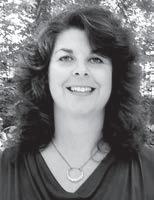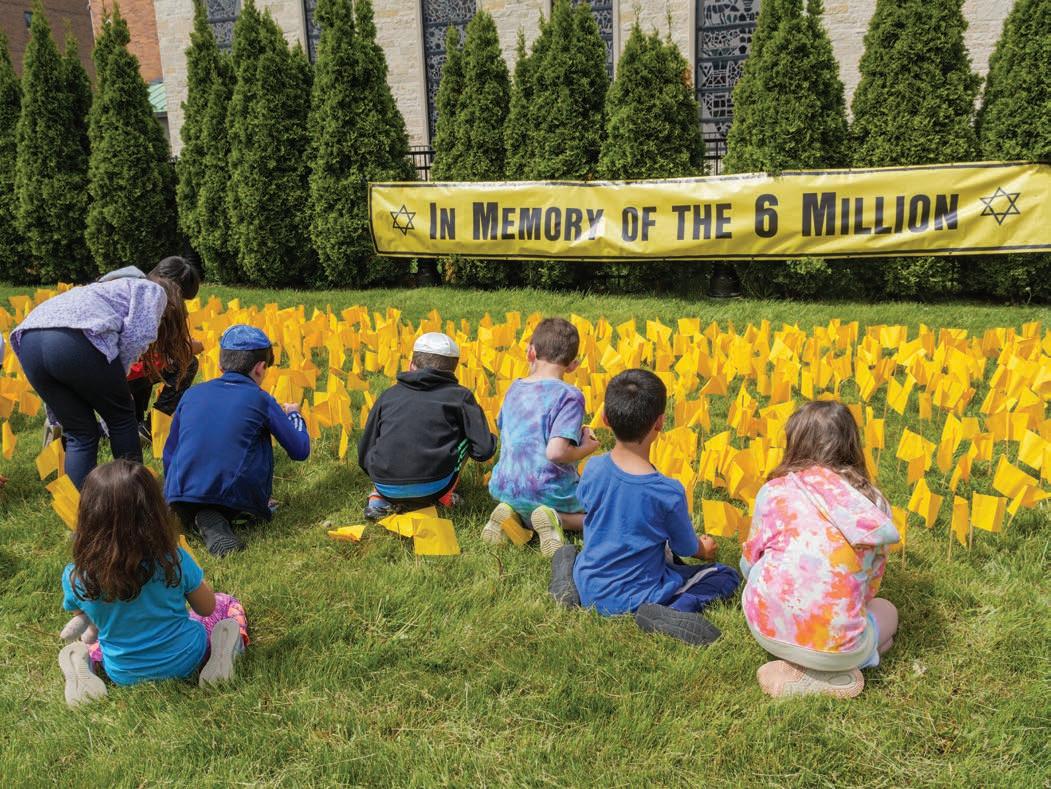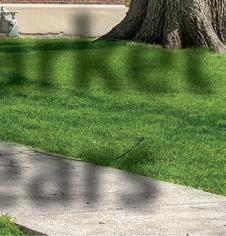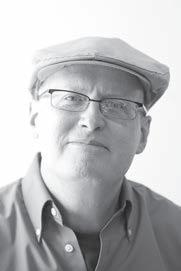
WEDNESD AY

MEMORIA M




WEDNESD AY



, PAGE 16

Concerns about Oak Park’s 2-year pilot include a lack of coordination with
A pilot program intended to change the way Oak Park responds to some emergency calls may be delayed after village trustees sent the plans back for re view. Trustees asked staf f to evaluate concerns about a divided response between village-employed mental health professionals and Thrive Counseling Center employees.
The proposed two-year pilot is called an “alternative response to calls for service” program that sends trained staf f in addition to, or sometimes in place of, police to mental-health crises and other low-level 911 calls.
In 2023, a village taskforce presented recommenda-
Sister Teresita Weind speaks at St. Catherine-St. Lucy Catholic Church in 2014 dur ing a retreat. ing for Weind, who preached homilies th at soothed and inspired. Teresita died of cancer last week See POLICE RESPONSE on pa ge




Alternative response from page 1
tions ab out how to respond to such Trustees later allocated $1.1 million the pilot progr am.
The idea comes amid a nationwide effort in which municipalities are reviewing what policing means for them, part as they address mental health crises.
“A traditional law enforcement response is likely to have a disproportionate effect on marginalized communities, including people of color or lower socio-economic status,” Oak Park village of ficials wrote.
The proposed model was put together with input from the taskforce, board goals, Illinois’ Community Emergency Services and Supports Act and the BerryDunn Community Safety study which the village missioned. It was presented to the Board of Trustees for the first time April 30.
At the meeting, some community members and mental health professionals said they’d prefer to see the village work more closely with Thrive Counseling Center, a local nonprofit, rather than creating a new program. The police department has long had a contractual relationship with Thrive

The proposal takes a four-pronged approach, covering responses to low-risk and high-risk mental health calls, as well as community care navig ation and non-mental health related calls.
Under the proposed plan, an internal team of mental health professionals or community service officers would respond to calls, with police and fire departments, when necessary. These calls could be from 911 or to the village directly.
■ For a low-risk mental health call, a team would include a mental health provider, peer support specialist, paramedic and/ or police officer. This team could respond to calls about a fall, a noise complaint or a confused person.
■ For high-risk mental health calls, the responding team would include a villageemployed licensed mental health provider, paramedic and police officer. Issues they would cover include calls about overdoses, domestic disturbances or suicidal ideation.
■ T he community care navig ation team would follow-up with services for residents who have already eng aged with the other teams. It would include a village-
Kira Tchang, the v illage’s human resources director, and Vanessa Matheny, the village’s grants manager, present the proposed model for alte rnative response to calls for ser vice dur ing the April 30 Oak Park Board of Trustees meetin g.
peer support specialist.
■ The final team would respond to nonmental health related calls that do not require a sworn police officer. A sworn police officer carries a gun and has arrest power. A non-sworn officer has neither. Consisting of unarmed community service officers, the team would respond to calls related to parking or other violations.
The village teams would operate for 10 hours daily under this plan, during what the village said would be “peak call hours.” Thrive, a comprehensive mental health center, would respond to calls, when necessary, the other 14 hours of the day.
Overall, the p lan would a dd nine employees to the village staf f. K ira Tchang , the village ’s human resources director, said the village would make it a prio rity to hire someone with mental health expertise to oversee the progr am. Th e pilot team members would not re po rt to the p olice chief, Tchang said, a ddressing a c oncern about inde p endent mental health assessment.
Social workers and peer support specialists on the teams would be sent to the scene separately from the police department. Village officials estimated they would spend about $80,000 on two new vehicles for the program, Tchang said.
The proposed pilot contains components to define “mental health crisis,” to train staf f, and to educate the community about how to reco gnize a mental health crisis.
sivity in all approaches.
A launch had been tentatively planned for the fall but may be pushed back given feedback.
Five residents, most of whom said they have experience as mental health professionals, expressed concerns about the proposal during public comment.
T hey asked the b oard to c onsider b olstering their partnership with Thrive, since their employees already respond to these t ypes of c alls. T he separation between Thrive and the village-emplo ye d teams duplicates wo rk and has the potential to create a disconnected response system, they said.
C heryl Potts, executive director of Oak Pa rk Township’s C ommunity Mental Health Board, and Jennifer Rook, executive director of Thrive, echoed the staffing concer ns
“While we [the taskforce] commend the Oak Park Police Department goal to have 100% of officers be crisis-intervention trained, data shows individuals who selfselect to be part of a crisis team are actually most effective,” said Potts, who cochaired the alter native response taskforce.
T he village already holds a $160,000 c ontract per year with Thrive, Rook said, to provide services. Thrive’s c ontrac t with the village is up in October 2024, unless it’s extended.
“Right now, we [Thrive] have a pulse on
could delay response time to an individual in need.
According to Police Chief Shatonya Johnson, Thrive sometimes takes up to an hour to get to the scene. Rook disag reed, and said they typically respond within 15 to 30 minutes.
The police’s primary concern is safety, Johnson said. After officers ensure a situation is safe, they diseng age and allow the appropriate professionals to deal with it, she said.
“I’m excited about this opportunity to collaborate and to make sure that we’re servicing the community to the best of our ability to ensure that the police isn’t causing any harm or have the potential to cause harm,” Johnson said.
The village is also working to make residents aware of the 988 hotline which connects callers to mental health support services through Thrive directly. If more 911 calls will be diverted to 988, where Thrive will respond, Potts questioned if it would be more prudent to bolster that partnership instead
Vi llage Manager Kevin Jackson sai d staf f will re-evaluate the proposal, taking i nto c onsideration the c oncerns that we re raised .
“This is exactly what we’re shooting for, is better inte gration,” he said. “Right now, [our response] is kind of fragmented.”
Village staf f had expected to present a resolution for board approval in May. That timeline is now likely to be pushed back
Thursday, May 9, 11 a.m. – 12 p.m., River Forest Public Library
This presentation covers the history & basics of Medicare. Listen & learn with Annese Piazza, a local resident and resource. Brought to you in partnership with River Forest Township. 735 Lathrop Ave., River Forest

Saturday, May 11, 2-3:30 p.m., River Forest Public Library
Speaker, author, and traveler Jeanne Roppolo joins us to share the story of her adventures in Antarctica. Jeanne was stationed in the frigid continent for ve months as a contract worker for the National Science Foundation. Tag along with “Grandma” on her ex treme excursion. Brought to you in par tnership with River Forest Township. 735 Lathrop Ave., River Forest
Sunday. May 12, 9-11 a.m., Oak Park Public Library

Featuring: Intergenerational stories of Oak Park APIDA mothers and families, appetizers/ desserts from Oak Park APIDA restaurants, and kids arts and craft activities. All are welcome! 834 Lake St., Oak Park
Tuesday, May 14, 9:30 – 11:30 a.m., Oak Park Public Library












The Creation of ‘Chicago!’

Monday, May 13, 1:15 p.m., Nineteenth Century Charitable Assiciation
Chicago native Bob Fosse shaped the 1975 musical Chicago! Subtitled “A Musical Vaudeville,” the show’s musical numbers include a pastiche of vaudeville performers or acts. Broadway musical historian Charles Troy will share the originals, the songs they inspired, and stories about Chicago in the 1920s and Maurine Watkins, the enigmatic author of the play on which the musical is based. Our programs are free and open to the public; donations are welcome. Reser vations: https://ncca. memberclicks.net/ 178 N. Forest Ave., Oak Park
Listing your event in the calendar
Many of us have become aware of scams a ecting older adults. What can we do to prevent becoming a vic tim of a scam and risking nancial setbacks? Come hear from a panel of experts about a variety of scams, how to recognize them, avoid them, and what to do if you’ve been victimized. Registration Requested at: registerAWNprogram@gmail.com 834 Lake St., Oak Park


Tuesday, May 14, 11 a.m. - 2 p.m., R Titus Designs Studio
Watch as our favorite furniture re -upholstery workroom brings new life to a vintage chair. We will show the room the chair going in, how we selected the fabrics, and what the chair needed to be new again. Light bites and refreshments will be ser ved. Due to limited space, we ask that you RSVP here: https://shorturl.at/qtvKS 143 S. Oak Park Ave, Oak Park
Wednesday, May 15, 7:30-9:30 p.m., Online
Zoom training for parents and caregivers of people with I/DD to suppor t your loved one’s mental health for comprehensive wellness. Reser ve a spot: https://tinyurl. com/4vs2kumn
Compiled by Brooke Duncan

Daniel Lakemacher, United States Navy veteran, spoke during non-agenda public comment in suppor t of a war cease re resolution at the April 30 Board of Trustees meeting.
The group’s drafted resolution calls for a cease re in the
A group of community members came back to urge the Oak Park Village Board of Trustees to pass a permanent ceasefire resolution for the Israel-Hamas war. The move on April 30 comes three weeks after the group first pressed the trustees to take action during a highly contentious board meeting. That April 9 meeting drew about 20 speakers during the non-agenda public comment to either support or oppose the resolution. The April 30 meeting was more subdued. Six people spoke to ex-
plain why they are still pushing to get the resolution passed.
Daniel Lakemacher, who said he is a United States Navy veteran that worked at Guantanamo Bay, explained that his experiences taught him about dehumanization, horrific treatment and torture, so he believes war is not the answer.
“I’m not asking you, as the village board, to ne gotiate international af fairs,” he said. “But what I am asking you to do is to re present, for our local residents, and for the wider world, what our values ar as a community.”
Caren Van Slyke, a founder and chair of the Committee for a Just Peace in Palestine/Israel, circulated an online petition supporting the resolution, which calls for “an immediate permanent ceasefire, the provision of immediate and unconditional lifesaving humanitarian aid in Gaza, and
1 HOUR A DAY Magical Minds Studio in Oak Park is looking for an experienced driver for their 14 passenger bus. No special license is required.











C ustomers at shops such as Se p hora, Old Navy and AT &T in downtown Oak Pa rk c an expect a new pa rk ing system i ntended to reduce abuse of the surface lot and eliminate the need for towing to go into effect soon.
The village and business owners have received complaints about the enforcement measures for parking restrictions at the parking lot at 401-435 N. Harlem Ave., 11281165 Westgate St. and 1137-1147 Lake St., said Emily Egan, the village’s development services director. Visitors to this lot were
often towed, a method of enforcement that often hurt business operations.
The new parking system
The new system will be in operation 24 hours, seven days a week. Under this method, the entrances and exits to the lot will have cameras that will collect a vehicle’s license plate as the driver enters and exits the lot. This is known as license plate recognition technology
Those in the lot for 30 minutes or less will not be charged. Customers of the shops of downtown Oak Park will be able to validate their parking through QR codes or through a text function, and also will not be charged. Shop merchants can validate parking even if the visitor does not buy an item but does browse the store. For visitors who park in this lot, stay more than 30 minutes, and do not get their parking validated, they will have to pay through a website,
Tan app or by phone call.
For 31 minutes to an hour, the fee will be $2. For one hour to two hours, the fee will be $4. The increments go up each additional hour by $2 until four to six hours of parking. For four to six hours, the fee is $12. Six to 11 hours is $17, and 11 to 24 hours is $24. The transaction fee may also be about $0.99 per parking session.
This surface lot, like The Emerson Garage, will not produce any revenue for the village. Both are private property.
To enforce this new system, visitors who leave without paying, when required, may receive an invoice in the mail with an additional fee. This fee would likely be about $50, according to a re presentative from SP+, the parking service lot provider. For non-repeat offenders, they can ask to have this f ee waive d.
T he system is i ntended to identify and send an invo ice to “chronic abusers” of the lot, said Ka rl C amillucci, the attor-
ney of the applicant, S DOP Co rp., a Delaware Corp oration.
If a re peat offender’s invoice is not paid and they park in the lot again, they could be towed. Towing is inconvenient but usually effective, Village President Vicki Scaman said.
“Towing is the only thing that changes people’s behavior,” Scaman said. “Once you have been towed, you don’t do it again.”
The license plate data will be stored for 90 days, according to village officials, as long as the parking session was paid. If a user does not pay or validate their parking, their license plate data may be ke pt for up to five years.
The way the system is set up, license plate data would be collected from any veSee PARKING on pa ge 8
he competition at Beyond Hunger’s Healthy Chef Challenge heats up on May 30 at Goose Island Barrel House. Three chefs from across Chicagoland will battle to make a gourmet entree using items commonly found in our food pantry. A panel of celebrity judges will determine which chef reigns supreme!
Join us for the competition, participate in our silent auction, engage in cooking demos by our Health Ambassadors, and enjoy food catered by BOKA plus open bar with wine and beer!
General Admission Tickets are $75 or you can opt for a VIP ticket ($150) which includes early admission, meet & greet
with the chefs & judges, a specialty swag bag, and a Goose Island tour with tasting.
Last year event revenues were enough to provide over 130,000 healthy and nutritious meals. Your support and attendance are crucial as we serve 52,000 individuals, the most households we have ever seen.






The sign is up. The windows are open. Café Cubano is open in Oak Park.
The smell of Cuban delicacies is wafting out of 113 N. Oak Park Avenue: coffee in the morning, mojitos in the evening, croquetas, ropa vieja, jibarito sandwiches, guava and cheese empanadas. The whole menu is making the move
On May 4, Café Cubano opened its doors in the for mer location of Fritz’s Delicatessen. The owners inked the deal to lease the spot 6 weeks ago. They closed their location on Restaurant Row just two-and-a-half weeks ago.
“I don’t know where we got the energy,” said co-owner Mayra Fernandez
Her husband and co-owner, Javier Fernandez, acknowledged that it’s taken every waking hour to get the place ready to go.
“This is wh at we wanted to do,” he said. “This is where we wanted to be at . I’m so happy. ”
T he couple have run Café Cubano at another location for more than 23 years. It’s a team ef fort
“His job is to mingle and say hello to ev-
cafecubanochicago.com
Address: 113 N. Oak Park, Oak Park Reservations: 708-456-6100
Hours: Sunday-Thursday 11 a.m.- 9 p.m.
Friday-Saturday 11 a.m.-10 p.m.
eryone,” Mayra Fernandez said. “And I’m going to be in the kitchen making sure everything comes out o.k.”
Expectations have been running high and people have been popping into the space whenever they’ve seen work being done, wondering when the restaurant will actually be open.
“They’ve just got such great spirit and vibrancy,” Oak Park President Vicki Scaman said at the ribbon cutting Friday. “The kind of energy that Cubano will bring, we believe is going to enhance the area and bring nightlife too.”
The process wasn’t without hiccups, but Javier Fernandez said he appreciates that the village pushed to get all the paperwork approved for them to open so quickly.




















When the factor y terminates operations this year, the facility’s land will transfer to a developer with a project to bene t the community
By JESSICA MORDACQ Staff ReporterIn January 2022, Mars Wrigley, the maker of Milk y Way, Snickers and Three Musketeers candy, announced its plan to move operations from its Chicago plant at 2019 N. Oak Park Ave. to its other facilities throughout the United States
It is now one step closer to determining what will happen to its property.
When it closes later this year, Mars Wrigley will transfer the 20-acre Chicago site to a developer and is in the process of finalizing who that will be.
“The ultimate goal is that it will provide benefit to the community,” said Anne Vela-Wagner, the executive director of the Mars Wrigley Foundation, about the future of the site. “What that looks like is quite complicated, and it’s been a very inspiring journey to go on.”
The process to find a developer to take over the Mars factory started in 2022, when a group of Chicago organizations — Austin Coming To gether, the City of Chicago, Galewood Neighbors, Northwest Center, and the Local Initiatives Support Corporation of Chicago (LISC) — organized a series of five meetings to collect community feed-
from page 6
hicle that enters the lot, even if the driver is just passing through. Owner information is not collected and stored, however, said Craig Failor, the village planner.
Trustee Cory Wesley, who voted against both agenda items associated with this plan, said he opposed the collection of data for drivers who are only passing through.
Trustee Chibuike Enyia agreed.
Camillucci said he could talk with the technology provider about ways to purge that information sooner for drivers who

back about what should take over the space at 2019 N. Oak Park Ave.
LISC compiled the main takeaways from the meeting into a re port, which recommends the site be a mixed-use space and receive historical designation.
The City of Chicago will decide whether to re zone the property from a Planned Manufacturing District to mixeduse zoning. The process is public, involving community feedback, and could take at least a year after a developer applies to change the site’s zoning.
“The re zoning aspect of this whole project is going to drive a lot of the timing,” Vela-Wagner said.
In October, the building’s facade on Oak Park Avenue was submitted to the Commission on Chicago Landmarks to receive historical designation. T he Mars Wrigley plant in Galewood opened in 1929 as the first of the company’s manufacturing sites outside of Minneapolis, Minnesota, and the factory housed its corporate head-
clearly did not park in the lot based on timestamps from the cameras.
Oak Park’s plan commission voted 6-2 in favor of the new parking system. At least one of the commissioners also did not like the disclosure of license plate data associated with this system, said Nick Bridge, a member of the plan commission.
Visitors can, however, opt in to having their credit card on file for convenience when paying for a parking session, Camillucci said. In that case, the payment information would be stored. He suggested those concerned about having their personal information stored not opt in for this option, in which case their payment information is purged immediately.
Trustee Brian Straw said he thinks there are better ways to use the land in down-
quarters there for decades. If the city approves the facade’s historical designation, the chosen developer is required to leave the facade
Mars received several proposals from developers to take over the site, according to Vela-Wagner. Criteria for choosing a developer includes the developer’s alignment with both Mars’ and the community’s vision, plus the developer’s past experience and financial terms, officials said in a statement with the process’ update.
But just because the Chicago Mars site will cease to exist, the candy company’s presence in the city won’t.
In January, Mars Wrigley announced the opening of a global research and development hub on its Goose Island campus, the world headquarters for the company’s snacking business, which will continue operations.
“We are definitely dedicated to the City of Chicago,” Vela-Wagner said. “We have a long history here and we honor that and want to continue to work closely with the community throughout this.”
Vela-Wagner said that the community eng agement process in preparing to transfer the Chicago factory’s property to a developer is a new endeavor for Mars.
“Transparency has been key,” Vela-Wagner said. “We’ re coming at this really grounded in mutuality. It’s one of Mars’ principles and how we work. So, it’s not just about what’s good for Mars, it’s about what’s good for everyone.”
“We feel we’ve been good neighbors,” she added. “We’ve been surrounded by good neighbors, and we want to continue that in the years to come.”
Vela-Wagner said Mars Wrigley will announce a developer in the next few months. The Mars factory will close before the end of the year.
town areas than promoting use of surface lots. He said allowing surface lots to generate revenue was a “poor precedent” to set.
“This structure starts to read as almost as predatory as towing,” Straw said, referring to the collections industry standards.
“This is not a predatory endeavor,” Camillucci responded. “This is really a property owner who is trying to respond to past criticisms from the residents, customers of its own property and the village.”
Trustee Susan Buchanan, who voted in favor of the new system, said she was “flummoxed” by her fellow trustees’ concer ns.
“Driving is a privilege,” she said. “Nobody has a right to free parking in downtown Oak Park … People need to change their parking behavior.”
The amendment to the zoning ordinance
for the new system passed 5-2 with Straw and Wesley voting against it. The ordinance granting a special use permit for the lot passed 6-1 with Wesley voting against it.
The trustees’ approval to the special use permit was conditional on two things: additional signage for parkers to be aware of the new parking fee system and development of a policy that is consistent with the village’s relationship with third party credit agencies. The village does not turn over past due tickets to credit reporting agencies, Scaman said. Staf f will approve this policy.
“I am not confident that this is going to do what you think it’s going to do in making more parking available for the people who shop at the shops in that lot,” Scaman said. “I just believe you have the right to make your own mistakes.”
The River Forest Park District’s proposed renovation of Constitution Park took a step forward after the River Forest Village Board instructed staf f members to continue with the planned development process April 28.
The action followed a presentation by Michael Sletten, park district executive direc-

tor, and Dennis Healy, board treasurer.
The Constitution Park project, which is expected to cost $1.6 million, is the first renovation of an entire park under the park district’s 2024 master plan, which was adopted after an 18-month process.
In the presentation, Sletten referred to “rearranging and realigning” the park at Greenfield Street and Franklin Avenue, which includes property near Willard School and owned by River Forest Grade School District 90.
Highlights of the proposed project include relocating and re placing the playground; adding a sitting area and a shelter with two restrooms; re placing the sand volleyball court; and swapping the ball field

and the soccer field.
The playground, which would re place one that is 17 years old, would be designed to be as accessible as possible, Sletten said. Designed for 2- to 12-year-olds, it would take up take up the same amount of space.
T he 20- by - 20-foot sitting area would be near the pl ayground, sand volleyball c our t and soccer field
T he b all field and soccer field would trade p laces with the b all field movin g from the D90 property and the socce r field moving to the D90 property. S letten said the pa rk district has used the D90 property under an i ntergove r nmental ag reement “for a long time.”
T he location of the sand volleyball c ourt, wh ich d oubles as an ice rink in winter, will be changed “slightly” bu t stay “generally in the same location, ” S letten said.
Officials are targeting May or June of 2025 for breaking ground for the project, pending approval by village officials and the Development Review Board. Sletten said officials have submitted an applica-
tion for a $600,000 Open Space Land Acquisition and Development Grant from the Illinois Department of Natural Resources to help fund the project but have sufficient funding to complete the project if grant funding is not available.
“We feel we have a strong application,” he said.
The project is expected to take eight weeks, during which time the park will be closed and fenced of f.
Officials are working with JSD Land Planners, which has worked with them previously, according to Sletten, who added officials were “happy with their service.”
Resident input on the project was obtained through multiple public hearings.
Sletten said “about a dozen” residents attended the most recent meeting, at which the “focus was very favorable.”
The process in developing the master plan has included the inventory and assessment of the parks; the review of the 2020 Community Survey results and resident comments; and a ranking by need of facilities and amenities for the parks.
Vintage 3 Bedroom, 1 ½ Bath, Long Hallways, 7 Large Rooms, Egress Windows, 3 Exits, 10 Ft Ceilings, Hardwood and Marble Floors, Wood Cased Windows, Brick and Ceramic Fireplace, Stained-Glass Windows, Crystal Wall Sconces, Arched Doorways, Sculpted, Plaster Walls, Cabinet Kitchen with Island and Granite Counter Tops, Walkout to 2 Level Deck over Backyard, Brick 2 Car Garage, Brick building with 400 Am Electric Service.
For

from page 5
the release of all hostages.” As of May 1, 524 people signed it, but the group is t rying to c ollect as many signatures as p ossibl e, Van Slyke said.
Resolution supporters held discussions with village trustees ahead of the April 30 meeting, Van Slyke told Wednesday Journal. Supporters have met with each trustee at least once, she said, and several more
Ithan once.
The trustees’ biggest question, she said, has been why it is appropriate for Oak Park to pass this type of resolution. As some residents who have opposed it pointed out, the issue is international, not local.
“It’s appropriate for them [the board] to pass it because our community is being impacted,” Van Slyke explained. “It’s not just any one of dozens of humanitarian crises in the world right now.”
Vi llage President Vi cki Scaman sai d the b oard will c ontinue to stay in dialo g ue with the c ommunity and “work to-
ward wh at is p ossibl e. ” T he b oard members did not elaborate at the meeting on whether they would entertain a resolution on the agenda.
The resolution’s supporters have also tried to emphasize that they are an inclusive group, Van Slyke said. Members of the Jewish and Palestinian community are in support of the resolution, she said, as well as individuals of other faiths and all ages.
“The crisis is accelerating with every passing day,” she said. “There is an unparalleled humanitarian crisis going on.”
Jim Madigan, a for mer deputy director

f you do, you should know how important foot care is. Over time, diabetics risk developing foot complications. When the nerves are damaged from chronic high blood sugar, feet can become numb or painful with burning or tingling. is is called diabetic neuropathy. When diabetes a ects the arteries, circulation to the legs and feet may be compromised. Either of these conditions may lead to serious problems including ulceration, even amputation.
e key to prevention is early diagnosis of diabetes, and regular foot exams from a podiatrist. Diabetics who receive regular foot care, including paring of calluses and debridement of thick fungal toenails, are almost four times less likely

to undergo an amputation than those who do not seek treatment.
Medicare and some private insurances cover 1 pair of diabetic shoes and 3 pair of protective insoles each calendar year. Dr. Lambert has been a supplier of diabetic shoes since 2002. e shoes come in 30 di erent styles each for men and women. ese include boots, lightweight colorful athletic shoes, and dress shoes. Even patients who are not diabetic love the look and comfort of the footwear. Diabetic socks, slippers and compression hosiery are also available.
Protecting your feet with appropriate footgear is an important aspect of preventive care for diabetics.

of the Oak Park Public Library, spoke during the April 30 meeting to express support for the resolution and to ask board members to use their voices to amplify those asking for a ceasefire, humanitarian aid and the release of hostages.
“My generation seems to have lost their idealism and settled for the lesser of two evils,” Madigan said. “Today’s youth rejects that compromise.”
Jenna Leving Jacobson, who said she’s Jewish, said Jews and Palestinians are not on opposite sides of this issue, and that many Jewish people do support a ceasefire.
“It is not enough for only Je ws to know freedom,” she said. “I f we fight only fo r our own rights and safety b ut do not ris e up for those in need alongside us, it is not enough. ”
The village board, she said, may not want to offend Jewish people, but Jacobson said she has not seen the same concern for Palestinian residents.
“Do not equate suppo rt ing Israel with suppo rt ing Jews,” Jacobson said. “Ther e is no neutral p osition. Our silence is c omplicity and will only encourage c ontinued suf fering.”
But other community members are still against the resolution. At the April 9 meeting, several other Jewish individuals expressed an opposition to the board passing a ceasefire resolution and their desire to not “alienate” local Jewish residents.
“The resolution initially seems to check all of the boxes for acce ptable wording … but it has many problems,” Judith Alexander said at the April 9 meeting. “Oak Park’s Jewish population feels frightened and alone.”
Alexander also wrote a letter to the editor in the Wednesday Journal explaining what she believes to be problems with a permanent ceasefire resolution.
In response, Van Slyke said resolution supporters have met with and reached out to those against it to have an “amicable” exchange of views.
Some have questioned why CJPIP and others in support of the resolution have not taken the issue up with federal officials. Van Slyke said they have, for about six months. But she also said elected re presentatives, including the local village board, can amplify their residents’ voices to those officials.
“If Oak Park joins with the other communities in Illinois … and these re presentatives start hearing that the elected officials closest to the grassroots are saying ‘You should do this,’ it’s going to have an additional, critical impact,” she said.
Finance expert Brooke Lapides, of Oak Park, wanted the right book to introduce her toddler to foundational concepts that would later make him a savvy adult.
She couldn’t find one. So the 39-year-old mom wrote her own.
“I couldn’t really find a book that went over the terms I wanted to explain to him so I thought I would just write it myself,” Lapides said.
In late April, she shared her knowledge of the world of finances with her selfpublished book. She debuted “Financial Fun from A- Z” and read as an author for the first time to fourth-g raders at Willard Elementary School in River Forest.
Lapides, who holds a master of business administration de gree from Marist Colle ge in Poughkeepsie, NY., said she always had an interest in helping other people understand financial literacy. Her 10 years in the mortgage industry also

brought Lapides opportunities to eng with others on the topic.
“I have done a lot of financial literacy classes,” Lapides said, including classes for soldiers and air union at a military installation. “They were 18,19 [years-old] — fresh out of high school and they didn
Having those conv agers — and even adults — who did not understand critical aspects of finances inspired Lapides to try to eng those conversations sooner
“Just knowing that so many adults make it to adulthood without basic financial literacy, I wanted to help combat that,” she said. “I just want as many kids as possible to read it so they ha standing finance.”
Lapides mulled tackling a children book for months. In the end, she said it took about a week of writing, although she credits the A-to-Z style of the book for making the process a “little bit easier.”
“I was able to write it and illustrate


it within just a couple of months,” she said.
At Willard, Josephine Mensah, 10, said she thought the book was interesting and found the simple language easy to understand.
“It explained it but it didn’t go into it too much to where there was too much info rm ation,” Josephine said.
Now that she knows what an “asset” is, Josephine said she believed it was important to learn about money.
“I couldn’t really nd a book that went over the terms I wanted to explain to him so I thought I would just write it myself.”
BROOKE LAPIDES
“You can use that info rm ation now, ” she said. “When you get older and yo u star t getting jobs as a ba by sitter or a
waiter, knowing how to manage your money and wh at is what … y ou’ll know wh at life is going to be li ke and how to manage your money.”
Heinz Hartmann, 10, said he has already been having conversations about money with his parents but also found the book helpful.
“It helped me add on to what I already knew about stocks and stuff,” Heinz said. “I liked the book and it is good for young kids to learn about finances in an easy way.”
“Financial Fun from A- Z” was released on Amazon on April 15 and is available as a paperback or an e-book.
‘I think there are more issues that are solvable in the local contex t,’ he saysBy RISÉ SANDERS-WEIR Contributing Reporter
First it was a movement to save Oak Park’s restaurants during COVID-19. Then it was founding an organization dedicated to improving the wider restaurant community. Now Oak Park Trustee Ravi Parakkat’s next feat is publishing a book to spread the word about Takeout 25’s local impact to the wider world.
On April 30, his self-published book “The Takeout 25 Effect” hit the stands – virtual and local.
Subtitled “mobilizing community for positive chang e,” the book traces a narrative of how the movement be gan and succeeded Parakkat said he believes that giving readers a behindthe-scenes look will “…create a recipe for application of this idea that worked well in this community.”
residents and volunteers in the Takeout 25 community banded together to save local restaurants. Although it is impossible to know to which de gree Takeout 25 was the reason, the fact is that few local eateries closed in Oak Park during COVID-19. The group soon spread the $25 challenge into neighboring communities, as well.
As the online community grew, the Takeout 25 team knew that there would be questions about who was behind it and skepticism about the goals.
“Right from inception was building that trust and credibility with the community to say, yes, I’ll be transparent about any funds that come here,” Parakkaat said. “I will spend it this way and you know. It’s open books. And then when the nonprofit came on board, then it becomes transparent automatically.”

“I felt like it could be applied in the context of other communities and to solve not just this problem but other problems,” he said.
The concept of the original Takeout 25 was simple math at time when restaurants and local businesses were closing around the state. If households in Oak Park spent $25 per week at local restaurants, that would push more than a million dollars per month into the local food economy. The idea caught on. Through a Facebook page,
from page 7
T heir existing Oak Pa rk c ustomer b ase was thrilled to hear about the move, Javier recalled .
“You’ re moving by me. Awesome. It’s
The success of that Facebook community inspired him and supporters to open a non-profit organization. Its stated goal is to enable sustainable local food systems and supply chains through a community-driven approach. One push is to help local restaurants compost their waste.
Daley Bagel and The Happy Apple Pie Shop are early adopters.
The reason for writing the book is Parakkat’s belief that good ideas can go farther with a map to follow.
“I think there are more issues that are solvable in the local context. What are the ing redients to make that work? How do you mobilize the community to support that, and how do you harness its power to really make it effective?”
Throughout the book, Parakkat explains
even closer,” he said.
He added that he feels he can bring new people to the area.
“I tell people I’m not here to compete with anybody. I’m going to bring in people that never made it down this way.”
The restaurant has a full bar. Music will be a part of every weekend. Live music and DJs will rotate through, bringing a party vibe to the brightly colored space.
how anyone can start a movement with no capital investment, using tools freely available to most people on the planet.
Back in 2020, as the Facebook group grew, a team of volunteers worked to keep comments positive. It eventually became a rule for the group. And it’s something that Parakkat said he believes is key to re plicating the outcomes. His hope for the book is that laying out the best practices that they discovered will help similar groups skip some of the growing pains that Oak Park’s group experienced.
Putting the guardrails on is key, he said, “to say this is how you think about this problem, and this is how you solve for this problem within these rules and within these guidelines so that everybody feels included and everybody can come and participate and they’ re able to prove the fact that you be as successful as a collective.”
Takeout 25 later expanded to building community among local restaurant owners and managers. This facet of the organization worked to break down barriers to collaboration and communication.
A Facebook group for restaurants only created community when there had only been competition before. One restaurant needed extra refrigerator space for a short time, another was able to use excess paper plates. The group permitted them to find help.
The growth in this restaurant-facing group helped Oak Park become the first Green Dining Hub in Illinois. Along with the Illinois Green Business Association, Takeout 25 is working to build the state’s first sustainable restaurant eco-system.
Parakkat said he also plans to work with larger organizations, such as the Illinois Restaurant Association and the National Restaurant Association, to get the word out about the group’s ef for ts and the book. En-
“We did change how we’re serving some things because before everything was like white rice, black beans and plantains, Marya Fer nandez said. “And some people want the other kind of plantain – the green one. We have two kinds: the sweet ones and we have the green ones, which are served with the garlic sauce. We’re serving Cuban rice.”
Now that the renovations are done and


Available in print, e-book, and audiobook
Locally: thepilebookstore.com

Online: bookshop.org, Amazon, Bar nes & Noble
dorsements for the book have ranged from local restaurateurs, non-profit leaders, and even an Olympic athlete.
The book is available now at local retailers and on many online platforms. A book launch event will be held May 13 at 7 p.m. in the Oak Park Public Library in the Veteran’s Room. RSVPs are encouraged through the library’s website or linked from takeout25.org.
While Ravi Parakkat used his personal funds to pay for the publication of the book, he has pledged a percent of any profit to be donated to the Takeout 25 organization.
The book is a case study, he said, “so that it can go beyond our borders and boundaries. The goal is definitely to get the message out into the world.”
the kitchen is open, Mayra Fernandez gives herself a moment to reflect.
“We did it! I was questioning it the whole way through, questioning myself. Can this really happen?”
Javier Fe r nand ez pointed toward the f uture.
“I just don’t want the village to be disappointed. We’re ready to go.”

Never forget
Children place yellow ags on the lawn at Temple Har Zion in River Forest in remembrance of the 6 million Jews murdered by the Nazis dur ing World War II to mark Yom HaShoah, Holocaust Remembrance Days on Sunday, May 9.






No one is in custody yet, authorities saidBy LUZANE DRAUGHON Staff Reporter
was shot in the foot at Scojust after 7 p.m. April 30. teenager was transported to Loyola rsity Medical Center, but has nonlife -threatening injuries, according to Dan Yopchick, the village’s chief communications officer. The victim was no longer hospitalized as of May 6, Yopchick said.
The Oak Park Fire Department and Oak Park Police Department responded to the incident at 7:03 p.m. The teenage victim was found in the entry of the Oak Park Public Library with a gunshot wound in his left foot.
Two shell casings were recovered from
the scene in the area between Scoville Park and the OPPL.
A man who lives on Lake Street, across from the OPPL, said he heard one gunshot. He declined to give his name.
Responding officers re ported about 20 to 30 juvenile individuals in Scoville Park when they arrived, Yopchick said, and there seemed to be an ongoing dispute between two groups of juveniles.
“Police believe that this was a targeted offense, however the victim was not the intended target,” Yopchick told Wednesday Journal.
No one is in custody, he said.
The OPPL at 834 Lake St. closed about 90 minutes early
Police removed yellow crime tape cordoning of f the area roughly an hour later. The Oak Park Police Department is continuing to investigate the incident, Yopchick said.
A 42-year-old man from Chicago was arrested for impersonating a police officer on the 400 block of Madison Street. The arrest occur red around 1:40 a.m. May 5 on the 100 block of Madison Street.
Someone stole a Chicago resident’s black 2018 Nissan Maxima May 2 on the 0 – 100 block of Erie Street. The estimated loss is $12,000.
■ Someone, possibly with a large rock, broke the double pane window of the door of M&M Property Management, at 506 Wesley Ave., between April 29 and April 30. The estimated damage is $1,500.
■ Someone broke the front windshield of two Oak Park resident’s 2023 Mazda and the front windshield of their 2014 Toyota Prius. The incident occurred May 2 on the 0 – 100 block of Lake Street. The estimated damage is $1,400.
A woman stole a bottle of champagne and clothing items from Target at 1129 Lake St. May 2. She also threatened an employee with bodily harm. The estimated loss is unknown.
Someone broke into a Naperville resident’s 2012 Honda on April 30 on the 1000 block of Lake Street. The person stole a bag containing jewelry, and the estimated loss is $1,300.
These items were obtained from Oak Park Police Department reports dated April 30-May 6, and represent a portion of the incidents to which police responded. Anyone named in these reports has only been charged with a crime and cases have not yet been adjudicated. We report the race of a suspect only when a serious crime has been committed, the suspect is still at large, and police have provided us with a detailed physical description of the suspect as they seek the public’s help in making an arrest.
Compiled by Luzane Draughon
In a 5-2 vote Tuesday night, Oak Pa Village Board of Trustees approved requir ing residents to bag leaves for collection starting in fall 2024.
This will end the practice of raking the leaves into piles on the streets.
Bagging leaves is intended to be a way to reduce safety issues associated with the leaf pile method, officials said, including fires lack of visibility, clogged drains — wh contributes to flooding — parking and bik ing issues, and children playing in lea Kids in leaf piles by curbs sometimes ca be seen by drivers, making the previous rite of passage riskier for them.
Residents and several commissions, including the aging in communities commission and disability access commission, have expressed opposition to the requirement to bag leaves. The top concerns, according to Erica Helms, the village’s environmental services manager, were costs associated with buying landscaping bags or hiring others to bag leaves and the physical demand associated with bagging.

Edward McCormick, of Oak Park, uses a leaf blower to move leaves into a pile near the curb for leaf pick up on Ridgeland Avenue in 2020.
couldn’t because the leaf bags and garbage bins will be located in different places, and doing it together raises the risk of mixing landfill waste with compostable leaves.
Parakkat, however, questioned whether the requirement to bag leaves would instead start to make residents view their trees as That could, in turn, disincentivize eople from creating and maintaining a een environment in Oak Park, he said.
Trustee Lucia Robinson pointed out that ssues with raking leaves into the street are not one-offs, but reoccur each year Sproule said car fires happen nearly every ear as a result of leaves in the street. The oncern about children playing in leaf piles going unseen by cars is also one Robinson brought up in earlier board discussions
“The emails that we have received, that are dismissive to that point, I quite frankly find appalling,” she said. “Someone’s child is going to be run over by a car … That way outweighs any convenience argument, from my perspective.”
Village President Vicki Scaman and Trustee Ravi Parakkat were the two opposing votes to the decision. Scaman raised concer ns about the cost of the program, lack of time for community engagement and quick turnaround for implementation this fall. Parakkat echoed resident and commission concerns about cost and physical demand, in addition to sustainability concer ns.
Ann Joachim, an Oak Park resident who spoke during public comment, said she’s opposed to bagging leaves because of the extra work and cost burden on residents. If village contractors were faster at removing leaves on the street, the safety concerns would disappear, she said.
Robert Larson, another Oak Park resident opposing bagged leaves, agreed that safety concerns could vanish with a quicker pickup time. He suggested the board put the issue on a referendum for the voters to decide Scaman acknowledged the village did contribute to higher piles of leaves when the collection program was reduced from eight to six weeks.
To counteract the cost and physical demand concerns, the village has come up with several proposals. One is to expand the current sidewalk shoveling program that allows those physically or financially unable to shovel snow or hire someone to do it for them to access free assistance.
The village allocates about $50,000 for this program, but because there was relatively light snow last winter, there are funds leftover, according to Rob Sproule, the village’s public works director. The contractor is on board with this idea and is putting together a proposal to bring to the village, Sproule said.
Another possibility, Helms said, is to create a fall leaf collection coupon program that would reduce the cost of leaf bags and drive sales to local businesses. The village has also considered having complimentary bags available in village buildings and at community partners including the Park District of Oak Park and the Oak Park Township.
To connect residents who need assistance bagging leaves with volunteers who can help, the village may create a community volunteer portal, Helms said. There
will also likely be a 24-hour hotline for residents to re port leaf violations.
One of the reasons the board cited to direct staf f to move forward with the bagging leaves proposal was sustainability. One option for those looking to avoid bagging is to simply leave their leaves where they fall and let them compost.
The village will be working to educate residents on the benefits of leaving their leaves to compost, including returning nutrients to the soil and protecting biodiversity in the environment. Leaving leaves also provides a habitat for insects like butterflies to thieve and benefits the overall ecosystem in Oak Park, Helms said.
The bagging leaves initiative will minimize greenhouse gas emissions from the heavy equipment required to pick up leaves from the street, Sproule said. Garbage trucks emit less, he said.
Trustee Cory Wesley questioned whether leaf bag pickups could happen at the same time as trash pickup. Sproule said it
She also suggested the village coordinate with service-oriented high school clubs to increase the number of volunteers available to help older or physically disabled residents bag leaves.
Trustee Brian Straw, who also supported the change to bagging leaves, said he appreciates the burden on residents to rake and bag leaves. A Wednesday Journal letter to the editor by Mark Wallace questioned whether the trustees would commit to bagging their own leaves, too. Straw said he would bag the leaves he can’t leave to compost.
The board also voted in favor of amending their contracted ag reement with Lakeshore Recycling Systems to switch from the previous leaf collection program to the bagging model. This amendment does not result in an increased cost to the village or its residents. LRS will honor the rate of $2.42 per month per household at least until the end of its contract in March 2027, according to the village
To ensure residents are educated about this change, Sproule said the village will work to have direct correspondence with residents in addition to village articles, newspaper advertisements and social media alerts.
The former pastoral associate at St. Catherine-St. Lucy Church was the rst Black woman to lead a global religious orderBy JESSICA MACKINNON Contributing Reporter
Remembered for her indelible impact on the cong re gation of St. Catherine-St. Lucy Church during a 12-year tenure — not only for the quality of her preaching and singing, but also re presenting cong re gants who were not typically seen in the pulpit — Sister Teresita Weind died on April 28. She was 81.
Weind, the first African-American woman to lead a global religious order, according to Black Catholic Messenger, was the epitome of grace, even in the midst of great challenges, people who knew her said.
“She deeply moved people’s hearts, minds and souls with her gentle yet powerful spirit. She was gifted and a gem of a spiritual leader,” said Gina Orlando, who attended Weind’s lectures and workshops, although her home parish was Ascension Church.
Born Helen Louise Weind in 1942, Sr. Teresita grew up in a large family in Columbus, Ohio. Her father died when she was young and her mother struggled to provide for her children, but insisted on sending them to a predominantly Italian Catholic school. She felt they would receive a better education there than at the segregated public school.
Weind was one of the first African-American students at the school. She often acted out, but curbed her behavior because of her interest in the school choir, which was led by a nun known to brook no nonsense. While she attended St. Joseph Academy in Ohio for her secondary education, she encountered the Sisters of Notre Dame de Namur, who became such role models that she was determined to join their ranks.
However, she was devastated to learn from the superior at Notre Dame that they had already filled their “quota of Negro girls” and were not accepting any more. It proved to be a temporary setback; Weind was accepted by the Sisters of Mary of the Presentation in Spring Valley, Illinois. After professing her vows in 1963, she was assigned to St. Andrew School of Nursing in Bottineau, North Dakota, where she completed her nursing training in 1966. She earned a bachelor’s degree in nursing at Mary Colle ge in Bismarck In the tumultuous summer of 1968, rocked by the assassinations of Civil Rights leader Martin Luther King Jr. and for mer U.S. Attorney General Robert Kennedy amid the backdrop of widespread protests against the Vietnam War, Weind joined 150 Black Catholic women in founding the National Black Sisters’ Conference in Pittsburgh. It was the beginning of a life-long advocacy for Black women religious and racial equality.
“It was important to see Teresita’s presence as a powerful and influential Black Catholic at St. Kate’s, an integrated church at the edge of Austin and Oak Park Wisdom emanated from her, and her faith was palpable. She was modest but a living example of how meekness should never be mistaken for weakness,” said Elliot Wimbush, retired pastor of First Cong re gational Church in Maywood.

ship committee. She was a dynamic, invigorating catalyst for the church’s racially diverse cong re gation.
Weind’s Good Friday services were memorable for Shelby Boblick, who served as president of SCSL’s pastoral council during the latter part of Weind’s tenure.
“She prostrated herself at the foot of the altar to begin the service, as is traditional for the presider. For many in attendance, seeing a holy woman of Sr. Teresita’s revered stature prostrate before the sacrifice of the cross was an embodiment and powerful witness that women are, indeed, public spiritual leaders,” Boblick said.
Her leadership and preaching were ahead of their time amid the complexities of the role played by women religious in the Catholic Church.
The Archdiocese of Chicago, however, didn’t appreciate Weind’s growing involvement and influence in the church. When Rev. Edward Braxton, whom many considered a stickler for propriety, took over as pastor in 1991, many of the ministries that Weind loved were taken away from her. She no longer was permitted to deliver the homily. She left the church soon after his ar rival.
In a 2014 Wednesday Journal ar ticle, Weind reflected on this difficult period. “I still love this [Catholic] church. I love it beyond the canonical restrictions that are placed on women. My faith keeps growing and deepening because my faith is my relationship with God, and Fr. Braxton did not take that away from me,” she said.
After leaving SCSL, Weind assumed increasingly substantial roles within the Sisters of Notre Dame de Namur, including serving as provincial of the Ohio Unit and, between 2009 and 2022, as cong re gational leader, based in Rome, a position that took her all over the world.
Feeling increasingly isolated in North Dakota, Weind jumped at the opportunity to join a team ministering in Chicago’s Cabrini-Green housing projects. While serving at St. Joseph Parish there, she earned a master’s de gree in religious studies at Mundelein Colle ge, with a thesis titled, “Black Theolo gy Begins in Preaching.”
The Archdiocese of Chicago reco gnized the valuable work Weind was doing and appointed her director of Liturgical Formation for Black Parishes. Her work also included overseeing adult religious education in the parishes in which she served.
While in Chicago, Weind became reacquainted with the Sisters of Notre Dame de Namur and realized she was still called to the order. A decade after they had denied her entrance, the order was ready to embrace her. She transfer red her vows and life to the order in 1973.
In 1979, Rev. John Carolan invited Weind to join the recently merged St. Catherine-St. Lucy Parish (SCSL) as a pastoral associate. He encouraged her to give the homily once a month, in addition to visiting the sick, giving retreats, singing in the church choir, and chairing the wor-
In early Se p tember 2014, We ind was welcomed back to SCSL as pa rt of the church’s 125th annive r sary c ele bration. During the weekend, she led a well-attended retreat and gave the homily — aptl y, about reconciliation — during Mass.
“During her homecoming … she preached, humbly and eloquently, about the long road to reconciliation. She encourages patience and perseverance because, as she puts it, reconciliation takes as long as it takes. But, in the end, it’s worth it because God’s gift to us is a deeper peace, which she sang about beautifully,” Wednesday Journal columnist Ken Trainor wrote in his book, Our Town Oak Park
Weind’s last assignment was providing pastoral care at Mount Notre Dame Health Center in Reading, Ohio, a ministry that was halted by a recurrence of her cancer diagnosis in March 2023.
“We all benefitted from Teresita’s talents and warmth and generosity,” said Pat Koko, who served as a staf f member at SCSL during Weind’s tenure and remained a good friend. “She is already missed in my life but remains in our prayers.”
A Memorial Mass is being planned for July 6, Weind’s birthday, at St. Catherine-St. Lucy. Details will be available through the church



















Adults: $69.00 plus taxes and gratuity
Children under 10: $34.50 plus taxes and gratuity ~Free unlimited Mimosa to all mothers~
Omelets Station
With a choice of Ham, Bacon, Mushrooms, Onions, Cheddar, Asiago, Mozzarella.
Waffle Station
With sausage links
Appetizers
Imported assorted Cold Antipasto, Oysters Rockefellers, Calamari (Fried and Grilled), Chilled Shrimp, Smoked Salmon, Sausage and Peppers, Bruschetta
Carving Station
Prime Rib, Pork Tenderloin with Ajus, Horse Radish, Ham on the bone
Entrees
Rigatoni Vodka. Tilapia Piccata, Chicken Vesuvio on the bone.
Tiramisu, mini-cannoli, Profiteroles, slices of Lemon, Oreo, and Pecan, and Fudge Brownie cake.


















































LASER HAIR REMOVAL: all skin types


WEIGHT LOSS





PRP: hair rejuvenation, natural ller








MICRONEEDLING: scar reduction, wrinkle reduction, skin tightening

INJECTABLES: Neuromodulators (Botox, Dysport etc), Fillers (Juvéderm, Voluma etc)






LASER SKIN TREATMENTS
· Laser Facial
· Wrinkle Reduction · Rosacea



· Age and Sunspots · Spider Veins · Onychomycosis · Wart Removal · Acne Treatment




















PERSONALIZED



79%


































































































Burger Moovment hasn’t moved, but it has changed hands. This beloved local slice of Americana has new owners who are just as dedicated to keeping the same high quality and flavor-packed menu that has been thrilling burger-lovers for the past 12 years.
When the restaurant at 7512 W. North Avenue in Elmwood Park was put up for sale Muhammad Komail and his partner Syed Mehdi decided to take a look. They were impressed with the offerings and the cleanliness of both the front and back of house.
“We just fell in love with it. The whole staff and everybody was great. And plus the food!” said Komail.
Komail previously worked in the tech field but felt a calling to be an entrepreneur. It was Mehdi who had the idea to run a restaurant together.
“We have known each other for over 18 years. He is like an older brother to me,” said Komail.
The new owners insist that Burger Moovment is staying the same. “We’re not changing anything drastic in the menu. The only thing that did change slightly was the turkey burgers. “I’d like to officially apologize to everybody who was coming here for the turkey burgers.” Komail said it is a supply chain issue and even turkey burgers will be back on the menu as soon as possible.
Signature burgers, like the South of the Moovment and the Carolina Gold Crispy Chicken, still keep company with the ever popular 8 a.m. Burger, which pairs a double meat patty with a fried egg. There is a


choose-your-own-adventure model, where ingredients can be piled on to satisfy individual tastes. And don’t forget their signature Moov sauce –secret recipe, but familiar to all burger lovers. Each month there are special offerings. In May a Torta de Mayo burger slips the flavors of Mexico between the buns. And there’s a featured shake. This month it’s dulce de leche. The two team up to create a Cinco de Mayo-themed double feature.
Premium shakes come in chocolate, vanilla, strawberry, cookies & cream, and caramel on the regular and are topped with a mound of whipped cream.




Fresh cut fries are a favorite. Each morning pounds of fresh potatoes are prepped for their transformation into crispy fried perfection in 100% vegetable oil. Sweet potatoes, tater tots and onion rings all get the golden treatment too.
In the past Burger Moovment was only on one delivery platform, but now most services can bring these taste sensations to customer’s doors.
The restaurant was also a regular supporter of local youth sports teams and other organizations. Komail and Mehdi will continue to weave the burger restaurant into the community.
One change that they’ve made, they see as an opportunity to enhance community outreach.
“When we purchased the restaurant, we wanted to make it open to all the communities in the area. So the menu is now 100% halal. This way it opens up for the Muslim community,” said Komail.
People with other dietary restrictions
can get their burger on too. Vegan Impossible patties and fish sandwiches extend the possibilities. Gluten-free buns and lettuce wraps are on offer as well.
“So pretty much anybody who wants to eat can eat,” said Komail.
One addition to the menu is wings. Great to go with the house dipping sauces: smoked BBQ sauce, honey mustard, cheese sauce, spicy chipotle, MOOV sauce, Carolina gold BBQ.
The business partners plan to franchise the restaurant. Until then Komail says they will “… keep focusing on the quality. That was something that I fell in love with and that’s what I want to continue.”
The Details: burgermoovment.com
7512 W. North Ave., Elmwood Park
Hours: Monday-Saturday 11 a.m. to 9 p.m. Sunday Noon to 9 p.m.


Better get your gobble on... it’s time to
With the turning leaves and crisp autumn breezes, Thanksgiving is quickly approaching. November’s Talk Turkey To Me is a juicy turkey burger paired with tangy whole berry cranberry sauce, home made griddle-seared stuffing and mayo on a toasted










Success (suk’sess) noun. A favorable result, the gaining of wealth or fame, a
Tom Carraher redefines the essence of
service. The achievement of success has most often been neglected by those who would compromise and settle for second-best. ...unless you select the uncompromising real estate services of Tom Carraher. The successful choice in real estate. Call Tom Carraher at 708-822-0540 to achieve all of your real estate goals.











You’ve decided to move to a senior living community, now what? If you have a home to sell, get it show ready by following these easy steps.
• Declutter, Depersonalize & Deep Clean. Help home shoppers focus on the house and not who lives there. Remove framed photos, bulletin boards and personal items, and get rid of anything dirty, dusty or smelly.
• Go Neutral. Buyers often can’t see past your décor so paint over any bright colors. Stick with whites, light gray, beige, or greige shades, they make spaces seem larger and more welcoming.
• Light It Up. Make sure all lamps and light fixtures have working bulbs and rooms are bright and well lit.
• Fix It Up. Repair small and large issues to present a home that’s been well cared for. If a project is too large to do it yourself, hire a handyman.
Remember, you only have one chance to make a great first impression with potential home buyers.
Visit Cantata.org for more senior living advice or call (708) 387-1030.

Vintage 3 Bedroom, 1 ½ Bath, Long Hallways, 7 Large Rooms, Egress Windows, 3 Exits, 10 Ft Ceilings, Hardwood and Marble Floors, Wood Cased Windows, Brick and Ceramic Fireplace, Stained-Glass Windows, Crystal Wall Sconces, Arched Doorways, Sculpted, Plaster Walls, Cabinet Kitchen with Island and Granite Counter Tops, Walkout to 2 Level Deck over Backyard, Brick 2 Car Garage, Brick building with 400 Am Electric Service.












 By LACEY SIKORA Contributing Reporter
By LACEY SIKORA Contributing Reporter
he last time 522 Linden was for sale, there was no cable television, no electric cars, no home computers and no internet.
In 1974, The Marion Street Mall in Oak Park was created by closing Marion Street at Lake. The Frank Lloyd Wright Home and Studio was bought from private ownership and was being restored, and residents were debating the village’s first high-rise development.
The home is one of only two in Oak Park designed by architects David Postle and John Fischer. Postle, who lived and worked in Elgin, designed many buildings in the Chicago area before moving to Los Angeles in 1921. Fischer worked as the head draftsman for Shepley, Rutan
and Coolidge from 1901-09 before working as the lead designer for Postle and Fischer from 191020. Fischer is known for designing many of the buildings on the University of Chicago campus.
In Oak Park, the duo first designed 420 N. East Avenue, and both homes were built by local builders Joseph Guy and John McClintock. When Wednesday Journal covered that home last year, local architect and founder of the Preservation Oak Park Facebook Group Chris Payne noted:
“In 1915, John Meier hired the firm to design his home at 420 East, and then in 1916, James Dick hired the firm to design his home at 522 Linden.”
James Dick was a member of the A. B. Dick family. A.B. Dick was a major American copier manufacturer and office supply company in the

from page 27
early 20th century. Dick was best known for developing the first commercial mimeo graph. T he homeowner recalled being told that Dick liked what he saw of the Meier house on East Avenue, so he hire d Postle and Fischer to design his house a few blocks away
“Both homes have a broad substantial appearance and like the firm’s other works, are Arts & Crafts inspired,” Payne said. “The Meier home has Prairie influences, while the Dick home has some classical motifs.”
522 Linden has an expansive brick exterior with an ornate, carved, decorative entrance. A porte cochere leads to the rear garage. An arched front door with an art glass window leads to an impressive foyer with original wood paneling. The paneling is echoed on the walls of the formal dining room. T he second-floor office is flooded with light from arched windows trimmed in rich wood.
At roughly 6,000 square feet and with 7 bedrooms and 4.5 bathrooms, the house has plenty of room to spread out. Compass Real Estate Broker Rubina Bokhari, said the owner is ready to sell after 50 years in the

home and touts the homes “amazing bones and layout.”

“It will just take someone willing to do the kitchen and the floors, but you don’ t want to touch that dining room, office or foyer,” she said of the need for some updates needed for the house, which is being sold in “as-is” condition.
Bokhari thinks the house is easily one of the most remarkable in Oak Park. She said, “The staircase is so grand with the banisters going all the way up. It’s like a Gatsby house. It’s great for entertaining.”
She also points out the versatility of the home’s floorplan for those looking to make the house their own. The second floor includes five bedrooms and three full bathrooms. The large primary suite includes its own sunroom. Bokhari said that it is easy to imagine expanding the closets in the primary suite and expanding some of the bedrooms.
With two more bedrooms in the thirdloor ballroom, Bokhari said, “This house has seven bedrooms. You could combine some and make bigger bedrooms. You could do so much with that ballroom- it could be a workout space or a guest suite. There are so many things you can do.”
For someone looking to make all three floors accessible, Bokhari can imagine removing the rear staircase and adding an elevator. At the end of the day, she said, “I think the buyer that buys this will make it their own.”
Bokhari said the house is priced competitively at $1.195 million. She noted that 420 N. East sold for $1.75 million last summer
“These houses have the same architect, are made of brick, are a similar size and are similar designs,” Bokhari said. “We realize this house needs updates. Put in $500,000, and honestly it will be worth even more than that in the future.”
At her first open house, Bokhari said that she had some unexpected guests. The family of the previous owners, who sold the house in 1974, stopped by with their entire family to tour the house. Bokhari said, “There were about 20 people coming through and reliving the family memories in the home. It was a treat. They took a big family photo out front when they left.”
She said she has no problem imagining the next owners will feel similar attachment to the home
“It requires a little bit of love, but it’s so special.”









“Our Town Oak Park – Walk with Me, in Search of True Community”, a new book by Wednesday Journal columnist Ken Trainor, an Oak Park native, is based on short essays, published over three decades in the local newspaper, that chronicle life in a dynamic, ever-evolving town where the unique meets the universal. The unifying thread is true community — nding it in the extraordinary ordinary, in the day-to-day, the face-to-face, the moments of beauty, and, as Thornton Wilder said of his play, Our Town, nding “a value above all price for the smallest events in our daily life.” Our Town Oak Park aims for that same “rainbow’s end,” capturing the experience of being alive — in one middle-sized, middleclass, Midwest town at the beginning of the 21st century. Join this pedestrian-friendly journey in search of true community.
The book is available at The Book Table, the Oak Park River Forest History Museum, or online via Amazon and Barnes & Noble.




We’re growing community, one story at a time.
Support our


FUND DRIVE
Welcome to Growing Community Media’s Spring Fund Drive.
Between now and the end of June, we’re working to raise $130,000 to support our nonprofit newsroom. With your active help, when we reach that goal, we’ll have completed our most successful year yet in total dollars raised and, happily, in the total number of readers supporting our journalism.
Every dollar from our readers goes into the newsroom to pay our hard-working reporters and designers to tell stories that unite and empower our communities. Each story we share serves as a building block in the foundation of stronger, more connected neighborhoods across the Greater West Side – from Austin and Garfield Park, into Oak Park, Forest Park and Riverside and Brookfield.
These are the communities we cover with our four publications. Austin Weekly News. Wednesday Journal. Forest Park Review. Riverside-Brookfield Landmark.
Over the next eight weeks, we’ll be sharing inspiring stories, showcasing the impact of our journalism and asking you to join us in keeping local news vital and strong.
Together, we will make a difference – one story at a time.
Let’s get this started. Invest in our newsroom at OakPark.com/donate
With gratitude.
Dan Haley Erika Hobbs Publisher Editor








Call Viewpoints editor
Ken Trainor at 613-3310
ktrainor@wjinc.com
On April 25, the District 200 high school board voted 5-1 adopting a Strategic Plan for the next five years that continues to prioritize racial equity efforts at OPRF High School. In doing so they rejected a call from a single board member who asserted it was time to stop prioritizing racial equity because that emphasis detracted from the equity needs of other students, especially gender non-conforming students
As a community member who worked on drafting the racial equity policy and procedures from 2018 to 2020, I will outline some of the history of how and why the board’s decision was the correct one
One View
The engagement of the community in drafting our racial equity policy and subsequent action plans five years ago was very clear about a central, guiding principle. In concluding that racial inequities were the most sweeping and historic inequities facing OPRF, the policy was also intentionally inclusive in declaring the importance of addressing inequities tied to class, gender, ethnic identity, disability, and sexual identity
With programs focused on racial inequities still in their early years, it is vital to seek unity around addressing all for ms of inequities while understanding why race is prioritized. This strategy must continue.
And when other inequities require attention and new initiatives, D200 must take action. The district did this last year in its massive capital improvements plan which addressed the facilities’ accommodation needs of disabled students, and provided gender neutral bathrooms and physical education locker rooms for gender non-confor ming students
In 1994 when the first significant community plea for racial equity took place in D200, the Oak Park Area Lesbian and Gay Alliance (OPALGA), Students for Peace and Justice, African American Parents for Purposeful Leadership in Education (APPLE), and the Oak Park chapter of the National Association for the Advancement of Colored People (NAACP) for med the coalition Building and Renewing Institutions Dedicated to Good Education (BRIDGE). The coalition called for the district to conduct a comprehensive qualitative review of OPRF to identify what was working


ublican Quality Bread (PQB) is now open in Oak Park (211 Harrison St.), tur ning out fresh breads in many shapes and sizes, as well as other baked goods (like pizza) under the direction of Greg Wade, 2019 James Beard Outstanding Pastry Chef/Baker. This is a big deal. We have some outstanding bakeries in Oak Park, but to have a baker of this caliber in the village will significantly up our bread — and pizza — game
Like many, I grew up with tavern-style pizza. This was a flat pie with a crisp crust cut into squares, “party style,” originally served for free at Chicago bars where patrons could grab a relatively small slice of salty cheese and sausage pizza … and buy more beer to wash it down.

Chicago is also home to deep dish pizza, of course, the hefty version of pizza first offered at what is now Uno’s Pizzeria. Rudy Malnati worked at Uno’s, and his son, Lou, started the pizza empire that has a location
in Oak Park.
All these pies are different from the generally recognized *original* pizza from Naples, Italy — the Margherita, light and thin, with toppings of just mozzarella, crushed tomatoes and basil, and a moist center that’s traditionally almost soupy.
Roman pizza has a thicker crust, much like bruschetta, and a wide range of toppings. Roman pie is usually sold by the piece (or al taglio, by the cut), and it was first served in the 1960s using high-protein flours that became popular during World War II and that help develop a crisp, thicker crust.
The substantial crust of Roman pizza puts an emphasis upon the bread, and that’s where Berwynite Greg Wade and his team at PQB shine. More substantial than tavern style, but less daunting than deep dish, Roman pizza treads the line between the two classic Chicago pizzas,
Oak Park is making headway on a complicated topic. They aren’t there yet.
The goal is to integrate an alter native response option for police calls which do not require a swor n and armed officer to arrive. These might be calls with a mental health focus or just a minor incident.
Under a proposed two-year-pilot a team of mental health professionals or a community service officer would be sent on some calls. In other cases, a blend of mental health and police staff would be dispatched.
The goal of de-escalating interventions which involve mental health concerns is critical. Still being discussed is the proposal to use both newly hired mental health pros while blending in contracted support from Thrive Counseling Center We’re still unclear on the seeming decision to have these new hires operate parallel to the police department and not be on the police staff. We also wonder if adding social-service capacity could allow for fewer swor n officers.
Mainly we are appreciative of the work of many people — a task force, BerryDunn consultants, police leadership, the village’s HR leaders — in bringing us to this hopeful place.
Sister Teresita Weind died last week. She was 81.
On staff at St. Catherine-St. Lucy Church in Oak Park for 12 years from 1979 to 1991, she was invited in by a priest, John Carolan, who saw the spark she had for preaching and the touch she brought to pastoral work. She was subsequently pushed out by another priest, Edward Braxton, who sought to extinguish that spark and could have cared less for her innate connection to people Braxton wanted to make bishop, and bouncing Sr Teresita scratched the profound anti-woman itch that still afflicts much of the Catholic Church. He wound up as the bishop of Belleville — you can look it up. Sr. Teresita was invited to Saginaw, Michigan to help run a parish with a pastor who valued her heart and her voice. From there, she rose steadily in the leadership of the Sisters of Notre Dame de Namur, eventually becoming the Congregational Leader, based in Rome. She held that post until 2022 when cancer returned
A dozen years after she was unceremoniously bounced from the pulpit at Washington and Austin, she was invited back in 2014 as the parish celebrated its 125th anniversary. In a long story at the time, the Jour nal reported on her ar ms-open reception by parishioners. When our reporter asked about her departure, she said, “I still love this church. I love it beyond the canonical restrictions that are placed on women. My faith keeps growing and deepening because my faith is my relationship with God, and Fr. Braxton did not take that away from me.”
In every way, a remarkable woman.
y recent draft of a village resolution calling for a ceasefire between Gaza and Israel [Viewpoints, April 24] elicited some noteworthy responses:
Jim Madigan was the only reader who submitted an alter native resolution, which has one distinct advantage over mine: Brevity. Here is his version: A response to the critical humanitarian crisis in Gaza

The Board of Trustees of the Village of Oak Park recognizes there is a major humanitarian crisis unfolding in Gaza with the displacement of more than a million people and the deaths of tens of thousands of Palestinian civilians — the vast majority women and children — as well as medical workers, international aid workers, and journalists.
We call for the provision of immediate and unconditional lifesaving humanitarian aid in Gaza
We recognize the only way to accomplish the delivery of such humanitarian aid is with an immediate permanent ceasefire.
We call for the release of all hostages.
We urge the Biden administration and the United States Congress to call for the provision of immediate and unconditional lifesaving humanitarian aid in Gaza, an immediate and permanent ceasefire, and the release of all hostages.
Other respondents to my column said passing any ceasefire resolution would divide the Oak Park community. But it would only be divisive if it were done without consensus and the village board probably won’t do that unless they get a nod from the pro-Israel community, which has already declared it a nonstarter.
So what kind of statement might we reach consensus on?
The pro-Israel side will never agree to any statement that doesn’t include eliminating Hamas, wrote Judith Alexander, who called my resolution well-meaning but naïve. But, she added, “I believe almost all of us care deeply about the welfare of civilians in Gaza and the West Bank. We join all of goodwill in hoping a sustainable way to peace is found and found soon.” She favors a petition instead of an official resolution, and that wording could include Judith’s call for eliminating Hamas, in addition to her expression of concer n for civilians caught in the conflict
Whatever form it takes, there is something to be said for the Oak Park community making a public declaration on an issue of moral import. There are precedents for starting such groundswells — voice by voice, butterfly wing by butterfly wing. The Civil Rights Movement, after all, probably sounded naïve at first.
What was it Margaret Mead reportedly said? “Never doubt that a small group of thoughtful, committed citizens can change the world; indeed, it’s the only thing that ever has.”
Too divisive? Our community is already divided. Is it better to remain silent and pretend fault lines don’t exist? Will talking about them make things worse … or better?
One commenter said he couldn’t support a resolution, but if there were a community call for dialogue among residents across areas of difference — including on antisemitism and Islamophobia — he would sign up
Consider it proposed and included in any joint moral declaration we might issue.
The need for a widespread nonviolent resistance movement in Israel, Gaza and the West Bank should also be included in our joint declaration. On May 1, the New York Times ran a profile of Issa Amro, a remarkable, nonviolent, Palestinian dissident in the West Bank who, if he survives the violence directed his way, might become the next Gandhi/King/Mandela. I suspect many Israelis would be willing to join such a movement alongside their Palestinian brethren.
Staying on the current path of win-lose, after all, is getting nowhere and leads inevitably to lose-lose. Gaza is losing the war militarily. Israel is losing it morally and spiritually. Both sides, as well as their supporters in this community, are hurting deeply, but with all the anger, too many fail to see the hurt on the other side It’s the pain of both camps that we need to talk about.
We also need to discuss our shared biblical mythology — the original rift between Isaac and Ishmael, the two sons of Abraham, from whom Jews and Muslims, respectively, are descended
We should talk as well about worshipping the false god of security, which leads to hunkering down in bunkers, fortresses being one of our most dangerous illusions.
We need to talk about the meaning of the Day of Atonement, the holiest day in the Jewish calendar, in ter ms of this conflict and how the only way to atone on both sides is to turn it into the Day of At-Onement. Minus a two-state solution, the only way to win-win this war is for Israelis and Palestinians to become one people, created — and treated — equal. The descendants of Isaac and Ishmael must become the brothers they were meant to be. They need to be at each other’s side instead of at each other’s throat. No longer can each side afford to say, “We must win. If you lose, that’s not our problem” while the other side says, “If we lose, then you must lose too.”
Biblically speaking, we are also descended from Cain, who killed his brother Abel, leaving us disAbeled. After committing humanity’s first murder, Cain famously asked, “Am I my brother’s keeper?” But we aren’t really each other’s keeper. We are each other’s ally. Pro-Palestinian and pro-Israeli Because we’re all related. We are family, like it or not, and always will be
But can we talk to one another?

This fall, our village will experience a significant change in how we manage fallen leaves. On April 30, the village board decided to switch from the current system, where residents rake leaves into the street for collection, to a leafbagging system.
The decision to transition to a leaf-bagging system was made with good intentions, focused on safety, but the potential implications and challenges it brings cannot be overlooked. These concer ns, along with the inherent complexities of such a transition, infor med my decision to vote No. I would have liked us to consider additional solutions that do not introduce the concerns I raise below while attempting to solve for safety Equity Concerns: One of my primary concer ns is the disproportionate impact this policy will have on our senior and disabled residents. Bagging leaves requires physical effort that may not be feasible for everyone, potentially making it harder for these community members to manage independently. This change could significantly affect our community’s inclusivity, especially for those who wish to age in place comfortably and safely.
Increased Costs: The transition to leaf bagging also means increased costs. Residents will now need to purchase bags, or the village will have to provide these bags. We will also spend more time and effort cleaning up and
bagging leaves, or pay for this service. These additional costs, some obvious and some hidden, have not been fully quantified yet. Ultimately, these expenses will be reflected in our taxes or in direct out-of-pocket costs for materials and services
Sustainability Implications: Although there are potential environmental benefits to bagging leaves, such as reducing the risk of blocked drains and less street cleaning required, I am concerned about the long-ter m impact on our community’s relationship with trees Viewing trees as a chore rather than a benefit can alter community perceptions and future decisions negatively. Additionally, the increase in material manufacturing and use (bags) and the uptick in bagging equipment use does not align with or contribute to our sustainability goals.
Nonetheless, now that the majority has spoken and the decision has been made, I encourage all residents to support the transition to this new program and make it as smooth and painless as possible. Please support your neighbors who may need a helping hand and also be patient with the village and each other as we work through this.
Stay tuned for more communication from the village on the specifics of this program.
Ravi Parakkat is a trustee on the Oak Park Village Board.
of Oak Park and River Forest
Editor Erika Hobbs
Digital Manager Stacy Coleman
Sta Repor ter Amaris Rodriguez, Luzane Draughon
Viewpoints Editor Ken Trainor
Real Estate Editor Lacey Sikora
Digital Media Coordinator Brooke Duncan
Columnists Marc Bleso , Jack Crowe, Doug Deuchler, Mary Kay O’Grady, Kwame Salter, John Stanger
Shrubtown Cartoonist Marc Stopeck
Design/Production Manager Andrew Mead
Editorial Design Manager Javier Govea
Designers Susan McKelvey, Vanessa Garza
Marketing Representatives Lourdes Nicholls, Ben Stumpe
Business & Development Manager Mary Ellen Nelligan
Circulation Manager Jill Wagner E-MAIL jill@oakpark.com
Special Projects Manager Susan Walker
Chairman Emeritus Robert K. Downs
Publisher Dan Haley

BOARD OF DIRECTORS
Chair Judy Gre n Treasurer Nile Wendorf Deb Abrahamson, Gary Collins, Steve Edwards Darnell Shields, Sheila Solomon, Eric Weinheimer
Our mission is to lead educated conversation about the people, government, schools, businesses and culture of Oak Park and River Forest. As we share the consensus of Wednesday Journal’s editorial board on local matters, we hope our voice will help focus your thinking and, when need be, re you to action.
In a healthy conversation about community concerns, your voice is also vital. We welcome your views, on any topic of community interest, as essays and as letters to the editor. Noted here are our stipulations for ling.
Please understand our veri cation process and circumstances that would lead us not to print a letter or essay. We will call to check that what we received with your signature is something you sent. If we can’t make that veri cation, we will not print what was sent. When, in addition to opinion, a letter or essay includes information presented as fact, we will check the reference. If we cannot con rm a detail, we may not print the letter or essay.
If you have questions, email Viewpoints editor Ken Trainor at ktrainor@wjinc.com.
LETTER TO THE EDITOR
■ 250-word limit
■ Must include rst and last names, municipality in which you live, phone number (for veri cation only)
VIEW’ ESSAY
■ 500-word limit
■ One-sentence footnote about yourself, your connection to the topic ■ Signature details as at left
Email Ken Trainor at ktrainor@wjinc.com or mail to
Despite an outcry of protests, village trustees decided 5-2 that we all must now bag leaves in the fall. It’s an emergency! Though one trustee recommended letting voters weigh in on the issue via a referendum, the board decided leaf collection was a crisis that needed urgent intervention. Leaves in the street are a great peril, they say, and bagging leaves or just letting them lie where they fall is much safer and more sustainable.
quicker pickup times, repositioning piles away from intersections, expanded community education, and other thoughtful measures In a public awareness campaign, remind people not to park their cars on leaves. Remind parents that they must supervise young children and teach them not to play in the street. No one wants to see children get hurt, and to suggest that people who oppose leaf bagging have an “appalling” lack of concer n for children is also … appalling
II’m not convinced. We have too many leaves (a lot of them from village trees planted in the parkways, I might add) to just “leave” them and expect them to compost over one winter. Every spring I rake up leaves that blew into my yard after my last raking in the fall. They didn’t decompose.
This seems like a fake solution to me
Before instituting what the village considers to be a sustainability measure, it should have conducted a local demonstration project in a public venue, to prove that its “leave the leaves to compost” strategy actually works. Leave all the leaves on the ground, for example, in the fall in all the village parks so we all can see how beautiful the park grounds look in the spring.
Bagging leaves is more sustainable? Did I miss the village’s analysis of how many bags will be needed each year and how many trees will have to be cut down to make those bags?
(Note to self: Small plastic shopping bags are bad; giant paper yard waste bags are good.)
Safety issues, such as car fires and children getting hurt, could have been addressed by
(Note to self: Leaves in the streets are dangerous, adding more and more bike lanes is not.)
Instead of tweaking a system that has worked well for 30+ years, the village has completely overhauled the leaf-collection system, pushing the labor and cost onto residents. It is reducing one of the basic services that we look to local gover nment to perform. Instead of taking pride in providing a greater level of leaf collection service than many other communities do, Oak Park is using the lower bar of other communities to justify doing less.
Local gover nment should strive to make life easier for residents, not harder.
All the leaf bags sold for use in Oak Park should come with the names of those trustees who voted for leaf bagging printed in large letters on them. Come fall, when we’re breaking our backs to stuff leaves into thousands of bags, we should remember who we have to thank for this wonderful new exercise: Susan Buchanan, Chibuike Enyia, Lucía Robinson, Brian D. Straw, and Cory J. Wesley.
Mark Wallace is a resident of Oak Park
We join the many Oak Park letter writers who have contacted you in opposition to the proposed leaf-bagging plan.
What problem is the proposed plan supposed to solve? My understanding is that the compensation paid by the village to LRS will remain the same, while considerable extra labor is done by homeowners who will also incur extra expense. Is someone getting a kickback?
I cannot imagine the frustration of trying to herd a pile of those dry fly-away leaves into a bag. Also, please consider the aesthetics Oak Park is (mostly) a very attractive town.
We enjoy generally good architecture (some of it great) and we live in an urban arboretum maintained by the village arborist. The vision of large paper bags stuffed with leaves lining the curbs strikes me as unattractive, compared with piles of natural leaves. And what will happen when autumn rains come and tur n those bags into large sodden lumps and sometime break?
Please retain the leaf pick-up program as it has always been as long as we have lived here (54 years!)
Ann & Jerry Bolan
Oak Parkoppose the village of Oak Park passing a resolution for a ceasefire in the IsraelHamas war. Such a resolution would be divisive and wrongheaded and would set a terrible precedent. Oak Park citizens elected representatives to run the village, not the world. Our trustees have no expertise in foreign policy matters, Middle East politics, the IsraelHamas conflict, just and unjust wars, military strategy, international law, or any other pertinent aspect of the proposed resolution; nor should we expect them to As a rule, the village does not adopt political resolutions or resolutions on how to conduct a just war. It is a wise rule. In a recent editorial, Wednesday Jour nal noted that a village board had once adopted a symbolic resolution declaring Oak Park a nuclear-free zone, as if such an action could be relevant to the current question. It isn’t. An elected municipal body should not weigh in with resolutions on issues that have nothing to do with its governance responsibilities.
One View
But I also want to clarify where I stand, as it may have relevance for thinking about potential consequences of such a resolution. I believe that a democratic state roughly within the Green Line borders of the current state of Israel, with a large majority Jewish population, is a good thing in the world — for Jews and everybody else — and, miraculously, it exists. I don’t want us to lose it. I believe that a Palestinian state should be established in the remaining territories of Palestine, with land trades for contiguity. Basically, this is the two-state solution that I think is the only remotely viable hope for peaceful coexistence among the peoples of the region.
Oak Parkers who object to the current U.S. policy on the Israel-Hamas war have many options for protesting it. Some have justified the proposed ceasefire resolution as a response to “a humanitarian crisis supported by Oak Park tax dollars,” as if the village of Oak Park sends local taxes to Washington to support the war. But if Oak Parkers are concerned that their individual federal income tax helps fund the war, they could withhold payment, as Thoreau refused to pay a poll tax in 1846 to protest the Mexican-American war. His principled act of civil disobedience got him arrested and jailed for a night, and we remember it today. But our local protesters, so far, have chosen a different path, attempting to pressure and persuade our trustees to play an active role in American foreign policy, based on very fragmentary and decontextualized information. Any responsible municipal board would reject the request.
The validity of my case against a ceasefire resolution does not depend on where I or anyone else stands on the Israel-Hamas conflict. It depends on how one understands the roles and responsibilities of a municipal governing body
The obstacles to such a solution are legion, well-known, and hugely challenging to even the best leaders and peacemakers. The solution is certainly impossible with Hamas in power in any part of the occupied territories. The events of Oct. 7 and the subsequent actions of Hamas leave no doubt in my mind that, in the interest of Israel’s survival, Palestinian self-determination, and eventual peace in the region, the capacity of Hamas for wielding power must be eliminated, just as Nazism was effectively eliminated, at great cost, through the efforts of the Allied powers during World War II.
I think my position is consistent with that of the Biden administration, and I’m confident that a good proportion of Oak Park residents agree with its broad outlines. I stand in fundamental disagreement with the local protesters advocating a village ceasefire resolution.
Adopting such a resolution would badly fracture the citizenry of Oak Park. It would be far better, I’d say, for the village board to sponsor or support teach-ins and forums around the issues involved in the Israel-Hamas war. Education and civil discourse would be the most responsible and constructive approach to our civic needs of this moment. We would all stand to learn a great deal, and we could set an example for other municipalities.
Steve Gevinson is a former OPRF faculty member and a former member of the District 200 high school board.
from page 31
and what institutional structures and culture features might be limiting the academic and social-emotional well-being of students.
In a manner similar to D200 committees that for mulated the district’s racial equity policy and procedures, BRIDGE did not view equity exclusively as a goal focused on Black students, even as they understood and agreed that racial injustice in education was the dominant historic and current issue facing OPRF. BRIDGE knew lesbian and gay faculty and students suffered inequities and har m as well.
In doing so, they shared the belief with equity allies that no one group of children or adults should take a number and wait in line for justice. In prioritizing race, BRIDGE believed our school community should and could at the same time in varied ways address other inequities. In fact, the intersectional dynamic of the BRIDGE effort contributed a few years later to OPRF becoming the first school in Illinois to adopt a policy to protect the human rights of lesbian and gay faculty and students
The standard that BRIDGE embraced in 1994, and that the community asserted in drafting today’s racial equity policy, still applies. It has guided curriculum equity in freshman restructuring, community collaboration for the last six years in hiring and retaining a faculty that reflects the racial and cultural diversity of our students, and in creating classrooms and other spaces that are safe, welcoming, and culturally inclusive
D200’s ongoing efforts tied to racial equity harken back to Dr. Jackie Moore, board president, when the district adopted its policy and protocols around racial equity. Moore wisely and resolutely reminded us that racial equity is not a zero-sum game where one group of students loses while others gain
In fulfilling both the letter and spirit of the renewed goal of racial equity at OPRF, D200 must be responsive to any members of our community who might be experiencing unrecognized inequities and harm. We need to face that situation and take corrective action, but not by diminishing our long-delayed efforts to address racial inequities endemic to Oak Park and River Forest and our nation’s social, economic, and education history.
John Duffy is a member of the Committee for Equity and Excellence in Education, a group of Oak Park and River Forest residents advocating for racial equity at OPRF High School.
Usually, when a school district commits to a multi-year strategic plan it involves a robust community discussion with many stakeholders. In fact, that was the normal process for OPRF High School in the past; not this time around. Such strategic discussions might include how the district has performed relative to the prior plan to help provide context and guidance re garding a new, and hopefully, improved plan for students. Additionally, the community, teachers, students, the board, and other stakeholders would be encouraged to participate. A facilitator would compile the feedback and consider topic-specific small group work. The process would then be completed with an agreed upon document/plan that the community can support because they were involved.
Well, our District 200 high school board just passed a new (old?) long-term Strategic Plan through 2028 that looks very similar to the past plan, with an added “Communications” priority. Where was the teacher, student, community, and open public board discussion? It is the board’s responsibility to develop/steer strategic planning and it’s the administration’s responsibility to execute those plans. The opposite just occurred
The administration drove the strategy by bringing a barely modified strategic plan document to the board with a recommendation to approve it. The board briefly discussed the utility of keeping equity as the school’s number one priority and then approved it through 2028; not a minor decision for our community
One board member dissented and appropriately wanted to discuss the usefulness of past priorities and noted that a normal, full, community-centric strategic review process did not occur.
What happened at the April board meeting
not only shortchanged our community, it circumvented the board’s responsibility of truly evaluating and setting the strategic direction for our school.
If OPRF were hitting on all cylinders it might seem reasonable to “stay the course.” But what if our current strategy has been decreasing overall student achievement and widening the achievement gap at the same time? What if national rankings are declining? What if employee or student culture is somewhat stressed or fractured? Does the board know? Where were the “courageous conversations” at the board table last month? Move along, “stay the course” nothing to see here.
As mentioned, the most visible change to OPRF’s “new” long-term Strategic Plan was adding “Communication” as a new “Priority 5.” This new public relations language included “By June 2028, improve issues management so that the number of community stakeholders agreeing or strongly agreeing that communications are open and transparent increases from 26% to at least 50%.” Shoving “Communications” into a long-ter m strategic priory plan at the end of the school year without genuinely engaging community stakeholders doesn’t sound very “open” or” transparent.” The Alanis Morissette song “Isn’t it Ironic?” comes to mind (https://youtu.be/Jne9t8sHpUc). Go Huskies,
■ Illinois State Re port Card Data: https://www.illinoisreportcard.com/ School.aspx?source=trends&source2=achie vementgapsat&Schoolid=060162000130001 ■ US News and World Re port Rankings: https://www.usnews.com/education/besthigh-schools
Ross Lissuzzo Ri ver Forest
When in Oak Park …
from page 31
tavern style and deep dish.
At the opening event, I chatted with Wade about his ’za.
“I’m really excited about the ve ggie pizza,” said Wade. “We’ re doing a classic Roma-style pizza dough with an arrabiata sauce, which is a slightly spicy garlicky tomato sauce. And then we’re getting these really fantastic dried tomatoes T hey’re not sun dried: they’re halfway between a fresh tomato and a sun-dried tomato, with deep, concentrated flavor but without the rubbery texture.
“Another one I’m really excited about,” he continued, “is the sausage and mushroom pizza. We’re doing a garlic-forward kale pesto for the sauce, and we’re using blue oyster mushrooms from Four Star Mushrooms, which are fantastic. We make the sausage in-house.” Sausa ge making is notoriously time-consuming and messy, but the focus on hand-crafted quality is what we ’d expect from One Of f Hospitality Group. Oak Parker Donny Madia is a par tner at One Of f, which has brought to Chicago acclaimed Chicago restaurants like Big Star and The Publican. PQB is good for the village, drawing people from other wester n suburbs and breathing new life into the Har rison Street neighborhood, which deserves more attention than it sometimes seems to receive. Pizza is served 4 to 8 p.m. every day.
David Hammond writes a blog for Oak Park Eats at oakpark.com.
I am concer ned about the design of recently streetscaped parallel pa rk ing sections in our village. I am not sure wh at the designers we re thinking when they put a 45 de gree angle curb at each end of these sections, but it seems to invite the misuse of those spaces. Dr ivers seeing wh at looks like an angled pa rk ing spac e, leave their vehicles with half the ca r obstructing the fl ow of traf fic. If these 45 de gree curbs we re
changed to 90 de gree curbs at each end, the village would actually increase le g al spaces by one for every section of parallel pa rk ing. If I counted co rrectly, I beli eve that would be at least 12 more spaces in the Lake and Marion shoppin g district alone
Suzanne Havertine, 74, of Chicago and Oak Park, died on May 3, 2024. A school social worker, she spent the majority of her career at the Proviso Area for Exceptional Children (PAEC) in Maywood, where she served students in the special education program as well as their families. She was also an avid reader and loved to travel. In her retirement, she volunteered at Housing Forward, an organization that provides housing and other services for unhoused families. Even when she could no longer physically volunteer, she remained passionately active
She is survived by many friends and family members.
In lieu of flowers, she wished for donations to be made to Housing Forward. A memorial Mass and celebration of life are being planned.

Robert Timothy (Tim) Yeager, 73, died on April 2, 2024 while undergoing treatment for recently-dia g nosed cancer. Born on Aug. 24, 1950 in Charles City, Iowa to Robert Benjamin and Bernadine Ann Yeager (Thompson), while attending high school he was the sports re porter for the Charles City Press, editor of the school newspaper, and an Eagle Scout. He avoided a tornado that hit his hometown in 1968 because he skipped pipe organ practice at the church that day. He spent several summers with his family collecting dental equipment, which they delivered to rural villages in Mexico, where his father provided free
dental care.
After earning his undergraduate and law de grees from the University of Iowa, he was admitted to the bar in 1978 and began his long service as a Legal Aid attorney providing free legal services to the poor. He served as district organizer of the Iowa/ Nebraska chapter of the Communist Party USA from the late 1970s until 1989, then settled in Chicago in search of new ways to serve the cause of justice. He became a union re presentative for his Midwestern Legal Aid colleagues, joined the National Organization of Legal Services Workers, UAW Local 2320 as org anizer, then became staf f counsel, and finally financial secretary in 2002. He remained active in the party in the Chicago area for years, organizing for change by building coalitions.
Tim married his first wife, Suzan Erem, in 1987. They honeymooned in the German Democratic Re public where in 1973 he had attended the World Festival of Youth and Students and the May Day Parade.
His daughter Ayshe was born in 1992 in Oak Park. Tim and Suzan divorced five years later, and in early 1998, he met Caroline Moores at the Ridgeland Green Line station and they married a year later in the garden of their new home.
He read for Holy Orders and was ordained an Episcopal priest through Grace Church in Oak Park in 2011. At his ceremony, his union brothers and sisters sang the labor movement anthem, “Solidarity Forever,” in a moving tribute to his commitment to social justice and his 2012, he became the priest-in-charge Andrew’s Church on the West Side of Chicago.
In 2014, it was time for Tim to mo Caroline back to her home countr UK, where he took up the Church land post of vicar at St. George Westcombe Park. He was instrumental in taking St George’s to its first Pride in 2020. He developed the Galilee Course, which is still running today received a Civic Award for Services Community of Greenwich in reco gnition of his selfless and compassionate work He enjoyed exploring the British Isles. In 2017, he and Caroline traveled to Germany to discover the Yeager-Thompson family house and farm where his great-greatgrandparents lived before moving to Iowa. He was well-known for his musical ac-
companiment at demonstrations, banquets, and church services on the piano, pipe organ, bagpipes, and accordion.
Tim is preceded in death by his parents, Robert “Bob” Yeager and Bernadine Yeager, and his ne phew, William Moores. He is survived by his wife Caroline Moores; his daughter, Ayshe Yeager; his brother, Dan (Jeanine) Yeager; his nieces, Hanna Yeager and Hillary Yeager-Davis (Kylar Davis); his brother-in-law Philip (Tracy) Moores, and his nephew, Alexander Moores.
A celebration of life will be held in the Chicago area in September. Visit timyeager.muchloved.com for a link to the video recording of the funeral, for details on the memorial service, and to post memories and condolences.
The family asks that, in lieu of flowers, donations be made to causes that honor Tim’s passion for justice. Among these are: Oxfam Gaza Crisis Fund, https://www. oxf am.org.uk/oxfam-in-action/cu rr entemergencies/gaza-crisis-appeal/; Medicin Sans Frontieres, https://www.msf.org/donate; and Onebodyonefaith, https://www. onebodyonefaith.org.uk.

Alice Margaret McCart, 77, died on April 26, 2024, in Overland Park, Kansas. Born on 19, 1947, in Leavenworth, to Kenneth Alvin McCart and MarElizabeth (Mills) McCart. The daughter of d around the an, Texas, and Iowa. It was in Mesquite, Texas, that she met and eventually married Robert McBride in June 1969, after earning a double Bachelor of Arts with honors in German and French at the University of Kansas. After the wedding, she went back to the University of Kansas to earn a Master of Arts in Teaching and German (1971), and a master’s de gree in Journalism (1983).
Alice and Robert had three children before they divorced: Elizabeth, Mark, and Maggie. In 1979, Alice started working in the U.S. Ar my Command and General Staf f Colle ge at Fort Leavenworth, translating German and French, was a production editor for Military Review magazine, military history, and an English teacher for new officers as the first civilian woman faculty in 104 years. She stayed in Leavenworth until 1986, then moved to Maryland for a year and finally to Oak Park
She worked as managing editor of Healthcare Financial Management Association before heading back to school to earn a JD de gree from the Chicago-Kent Colle ge of Law in 1993. She opened her own law practice in the historic Monadnock Building in downtown Chicago. After a few years, once all her kids had left the nest, she headed back to Washington D.C. and became the managing editor for American Health Lawyers Association and American Corporate Counsel Association publications. She was living in D.C. on Sept. 11, 2001, and held that experience in her heart for the rest of her life. Eventually she headed back to the place that was always home, Kansas, and worked with her lifelong friend and colleague, Jon Tomes, of Veterans Press Inc. and EMR Legal Inc. becoming one of the nation’s leading experts in HIPAA compliance and other health-care-related privacy law and electronic health information standardization.
She developed a love of running in the 1980s that stayed with her for over a decade, including 5Ks, fun runs, and marathons. She had a special relationship with nature, and the environment was an interest for most of her life. She became a ve getarian in the ’80s and a ve gan in the ’90s and loved sharing ve gan recipes with just about anyone who showed even a passing interest. Throughout her life, she always of fered her editing skills to anyone who needed them for any type of book, professional paper, or just to help young professionals polish their resumes and cover letters.
Alice is survived by her three children, eight grandchildren, and one great grandson.
A Celebration of Life was held on May 3 at Davis Funeral Chapel, 531 Shawnee St., Leavenworth, Kansas 66048. In lieu of flowers, please send memorials to the American Diabetes Association.
Please contact Ken Trainor by e-mail: ktrainor@wjinc.com, or fax: 708/524-0447 before Monday at noon. Please include a photo if possible.
Fenwick High School senior Timothy Fischer has a strong background in water polo. Growing up in Chicago, he took part in several park programs and played for the Chicago Park District club.
“This of fered me the opportunity to grow in a diverse community where I was able to learn how to work with all different people, which is an invaluable skill to have in the pool and life in general,” he said.
Fischer has put that experience to good use with the Friars, helping them win three consecutive Metro Catholic Aquatic Conference championships. Moreover, he has garnered All-MCAC, All-Sectional, All-State, and AllAmerican honors.
Fischer credits his father, Eric, and his late grandfather, Art (both of whom are in the Illinois Water Polo Hall of Fame) for helping him craft his success.
good job of ear ning everyone’s trust and exposing us to a different style of game play.”
Lessons learned at Fenwick: “The importance of dedication, teamwork, and the value of time. Through trust in the team and my dedication, I have achieved things I never thought possible as a wide-eyed freshman. Now that it’s almost over, I understand how precious the time I had in this school was and am glad I was able to accomplish something with it.”
Favorite Fenwick water polo memory: “Playing in the De Smet Invite (St. Louis) my junior year. As our only travel tournament of the year, it gave the varsity a chance to bond and perfect our game together. We fared well as we placed third.”

Colle ge plans: “Although I haven’t decided yet, I fully intend to play water polo at the collegiate level. I am between two schools and will be making my decision very shortly.”
Favorite food: “The five-piece spicy tender combo from the Popeye’s next to Fenwick.”
“Throughout my entire life, my family has helped mentor and advise me,” he said. “This ranges from tips after games in areas where I need improvement to practicing in the pool.”
Here’s what else Fischer, one of this week’s Wednesday Journal featured student-athletes, had to say:
On this season: “It’s been successful so far. We have only lost to some of the top teams in Illinois, most of which we were down key players. I think we have what it takes to place well in the state this year.”
On how the team has adjusted to new head coach Beto Garcia: “Although the team had grown accustomed to the prior coaching style, Coach Garcia has done a
Favorite music: “Mariachi.”
Famous person he’d like to meet: “Pope John Paul II. I took his name upon my confirmation and really look up to him.”
Biggest issue facing teens: “The attribution of our time and energy into pointless things rather than friends, family, or our education. So many people of my age are addicted to the fast-paced media on their phones and other devices. Most of it has no real value other than releasing dopamine into people’s heads. I believe the rise in mental health problems in young adults is a result of this.”
Three words to describe himself: “Inquisitive, dedicated, and hungry.”

Oak Park and River Forest High School senior Lilianna Jasinska is headed to her fourth badminton state tournament in doubles and second in a row with junior Anika Gupta. The experience improves every year.
“Playing with Anika makes it feel better because we’re so supportive with each other and we’re such a good team,” Jasinska said.
“[State] feels great and every single time, I’m so shocked. I love going because you play such a variety of people with so many different skills. It’s completely different from [the re gular season] and I think it’s going to be really fun to go with Anika.”
Jasinska and Gupta qualified again by taking third at the York Sectional Thursday with a 4-1 record. Top-four sectional finishers advance to state Friday and Saturday at DeKalb High School.
At 2023 state, Jasinska and Gupta were top-24 finishers with a 3-2 record after losing their first match. They were one victory from playing on Saturday last year.
“If we improve from last year, maybe make it to the second day [we’d be satisfied],” Gupta said. “[State] has been our goal the whole season so to finally be able to achieve it feels so good.”
This is the 12th straight season the Huskies have had state qualifiers, dating back to 2012 (there was no 2020 state meet). Jasinska is believed to be their first four-time state qualifier in at least 20 years.
“That’s a pretty big accomplishment,” OPRF coach Paul
 Jasinska
Jasinska
Wright said. “These kids put a ton of time in during the offseason and it just really shows. [Jasinska and Gupta] practice together in the offseason occasionally. They have a really good relationship.”
What’s most impressive about OPRF’s streak is that the majority of the players enter the program with little to no experience.
“Ninety-five percent of those girls have never played organized badminton until they came to OPRF,” said Wright, in his 12th season. “Our success is a testament to my coaching staf f and the commitment from the girls and parents to get better during the off-season.”
The Huskies outlasted Lyons Township juniors Mia Graziano and Simone Brown 14-21, 21-19, 23-21 in the thirdplace match — fighting of f three match points after trailing 20-18. They qualified by winning their previous match 21-18, 21-18.
OPRF’s other doubles team of seniors Kathelyn Wallace and Ella Papandreou was 3-2 and came one victory from state, losing to Graziano and Brown 21-11, 21-17 in the determining match. In singles, junior Alice Cadwell was 1-2 and senior Sophia Jo zefczyk was 0-2 with both players receiving one bye.
Before last season, Jasinska and Gupta had never met. Jasinska played her first two state meets in doubles with 2022 graduate Amelia Hoog, going 1-2 both years.
Seeking a new partner, Jasinska quickly noticed the “sophomore prodigy” during tryouts. Gupta had been on the 2022 freshman team.
“I played her during singles [at 2023 tryouts]. That’s when we kind of established Anika was definitely really good and it would make the most sense for me to play with her,” Jasinska said.
“[Jasinska] just started hitting with me. I was an underclassman so I was like, ‘OK,’ ” Gupta recalled. “I learned [that state is] a lot of fun. But I think I learned a lot about the mental game because working with a partner under stressful conditions, it’s hard to do. I think I learned how to stay positive, cheer on your teammate and be in there.”
Wright said Jasinska has proven to be a great model for Gupta and the program, just as Hoog was for Jasinska, and Gupta is becoming.
“I’m kind of keeping up the tradition,” said Jasinska, laughing. “It’s super-fun [at state] and I definitely wouldn’t have been able to do it without my coaches and teammates. I’m shocked and really happy every time.”
Melvin Tate contributed to this story.
As a player at Oak Pa rk and River Forest High School, losing didn’t happen often for first-year Trinity softball coach Chardonnay Harris. The Huskies were back-to-back IHSA Class 4A state champions in 2016 and 2017, and Harris was 19-0 with a 0.29 earned run average in her senior campaign With the Blazers’ program fielding only a varsity team this spring, some growing pains were expected, with one sophomore and five freshmen on the roster. And that has proven to be the case as Trinity enters
this week with a 4-15 record with a fivegame losing streak.
But the Blazers have been competitive for the most part, as six of their losses have come by four runs or less. The last three games, however, have yielded difficult defeats.
On April 30, Trinity gave up nine runs in the first inning against visiting DePaul Prep. But the Blazers’ bats came alive and sparked a furious rally that pulled them within one after six. Unfortunately, the Rams iced things with a three-run seventh and prevailed 16-12.
On May 2, Trinity led Wheaton St. Francis 8-5 after six. But the visiting Spartans staged
a five-run rally in the top of the seventh to stun the Blazers 10-8.
Two days later at IC Catholic Prep in Elmhurst, Trinity banged out 15 hits, including three apiece by Kendall Hynes and Aly Lopez. But it wasn’t enough as the Knights broke open a tight game with a four-run sixth to seal a 9-5 victory.
There are some bright spots for the Blazers, particularly at bat. Lopez, a freshman, leads the team with a 542 batting average, while Hynes, a senior, is hitting .476 with 16 RBI. Junior Claire Rambasek has a .500 average. Senior Sofia Samatas is hitting .452; senior Anais Fer nandez, .393 with a team-
high 18 RBI; and sophomore Grace Samatas, Sofia’s sister, is hitting .344.
The problem for Trinity has been pitching. The Blazers have a posted a team ERA of 9.40, which makes it difficult for any team to win games even if the offense produces. The good news is that Lopez and Grace Samatas are gaining much-needed experience in the circle, which should serve them well in the future.
Trinity’s goal is to finish the season strong and lay a foundation for the next few years. While she’d like to have a few more victories this year, Harris is taking a long-term approach to building the Blazers’ program.

HOURS: 9:00 A.M.– 5:00 P.M. MON–FRI
Monday at 5 p.m.


NOTICE OF PUBLIC MEETING
On Friday, May 24th at 9:00 a.m. a meeting conducted by Brookfield-LaGrange Park School District 95 will be taking place at S.E. Gross Middle School, 3524 Maple Ave. in Brookfield, in the 2nd Floor Conference room. The purpose of this meeting will be to discuss the District’s plans for providing special education services to students (who reside within the boundaries of Brookfield-LaGrange Park School District #95), with disabilities who attend private and home-schools for the 20242025 school year. If you have further questions pertaining to this meeting, please contact Dean Pappas, Director of Student Services, at 708-5888863 or dpappas@district95.org
Published in RB Landmark May 8, 2024
All real estate advertising in this newspaper is subject to the Fair Housing Act, which makes it illegal to advertise any preference, limitation or discrimination based on age, race, color, religion, sex, handicap, familial status or national origin, or intention to make any such preferences, limitations or discrimination.
The Illinois Human Rights Act prohibits discrimination in the sale, rental or advertising of real estate based on factors in addition to those protected under federal law. This newspaper will not knowingly accept any advertising for real estate which is in violation of the law. All persons are hereby informed that all dwellings advertised are available on an equal opportunity basis. Restrictions or prohibitions of pets do not apply to service animals. To complain of discrimination, call HUD toll free at: 1-800-669-9777.
GROWING COMMUNITY MEDIA
INVITATION TO BID LANDSCAPING
The Board of Education of Oak Park Elementary School District #97 will receive sealed LANDSCAPING SERVICES bids at the Administrative Office located at 260 West Madison Street – Oak Park, IL, (60302), until 3:00 p.m. on Friday May 24, 2024. A MANDATORY PRE-BID MEETING WILL BE HELD ON FRIDAY, May 17, 2024 AT 1:00 P.M. AT THE DISTRICT OFFICE, 260 Madison Street, Oak Park, IL 60302
Bids mailed or delivered shall be marked to the attention of:
Mr. John Pahlman Oak Park School District 97 260 Madison Street Oak Park, Illinois 60302
The front of the envelope should be clearly marked “LANDSCAPE SERVICES”. Additional information may be obtained by contacting Mr. John Pahlman at (708) 524-3125 or jpahlman@op97.org
Bid Due Date: Friday, May 24, 2024. at 3:00 P.M.
Only those bids complying with the provision and specification of the bid will be considered. The Board of Education reserves the right to waive any informalities, qualification or irregularities and/or reject any or all bids, when in its opinion, such action will serve the best interest of the Board of Education of Oak Park Elementary School District 97.
Published in Wednesday Journal May 8, 2024
PUBLIC NOTICES
RIVERSIDE BROOKFIELD TOWNSHIP HIGH SCHOOL DISTRICT 208
TIMELY AND MEANINGFUL CONSULTATION FOR PARENTS AND ADMINISTRATORS OF PRIVATE AND HOME SCHOOLED CHILDREN WITH DISABILITIES
In accordance with the requirements of Section 612(a) (10) of the Federal Individuals with Disabilities Improvement Act of 2004 (“IDEA 2004”), Riverside Brookfield High School will conduct a Timely and Meaningful Consultation on Friday, May 17, 2024, at 10:00 AM at Riverside Brookfield High School, 160 Ridgewood Road, Riverside, Il 60546 The purpose of this meeting is to discuss how students with disabilities, who attend private schools or are homeschooled within the district boundaries, will be served by District 208 during the 2024-25 school year
Parents and private school administrators who would like to attend should contact Kevin Baldus, Director of Special Education, at baldusk@rbhs208.net
Published in RB Landmark May 8, 15, 2024
PUBLIC NOTICE STATE OF ILLINOIS VILLAGE OF BROOKFIELD
Notice of Public Hearing Village of Brookfield Planning and Zoning Commission May 23, 2024, at 7:00 PM NOTICE is hereby given that a public hearing will be held by the Planning and Zoning Commission of the Village of Brookfield on Thursday, May 23, 2024, at 7:00 PM in the Edward Barcal Hall located at 8820 Brookfield Avenue, Brookfield, Illinois to consider an application from Li Dong for a Special Use Permit to operate a Massage Establishment use at 9211 Broadway Avenue (PIN 15-34-307026-1003).
Legal Description: UNIT NUMBER 9211 IN 9207-9213 BROADWAY CONDOMINIUM, AS DELINEATED ON A PLAT OF SURVEY OF THIS FOLLOWING DESCRIBED TRACT OF LAND: LOT B IN MRAZ SUBDIVISION OF LOTS 1 AND 2 IN BLOCK 1 IN PORTIA MANOR, BEING FREDERICK H. BARTLETT’S SUBDIVISION IN THE SOUTHWEST ¼ OF SECTION 34, TOWNSHIP 39 NORTH, RANGE 12, EAST OF THE THIRD PRINCIPAL MERIDIAN IN COOK COUNTY, ILLINOIS. WHICH PLAT OF SURVEY IS ATTACHED AS EXHIBIT “A” TO THE DECLARATION OF CONDOMINIUM RECORDED MARCH 17, 2009 AS DOCUMENT NUMBER 0907645123; TOGETHER WITH ITS UNDIVIDED PERCENTAFE INTEREST IN THE COMMON ELEMENTS.
The public is invited to attend the public hearing and present oral and/ or written comments. Written comments may be provided prior to 4:00 PM on the day of the meeting to: Village of Brookfield, Planning and Zoning Commission c/o Kate Portillo, 8820 Brookfield Avenue, Brookfield, IL 60513 and at kportillo@brookfieldil.gov. Oral or written public testimony may be given during the public hearing.
The application may be viewed at the Village of Brookfield Village Hall during normal business hours. Please reference PZC Case 24-09. Public hearings may be continued from time to time without further notice, except as otherwise required under the Illinois Open Meetings Act.
Individuals with disabilities requiring accommodation in order to participate in any meeting may contact the Village of Brookfield at (708) 4857344 prior to the meeting. Wheelchair access is available through the front (south) entrance of Village Hall.
By the Order of Chuck Grund, Planning and Zoning Commission Chairman.
Published in RB Landmark May 8, 2024















Two Inherent homes on the 600 block of North Ridgeway Avenue are available for first-time buyers under the city’s Building Better Neighborhood and Affordable Homes program.
The Better Neighborhoods and Affordable Homes program offers qualified buyers up to $100K in down payment assistance
By DELANEY NELSON and FRANCIA GARCIA HERNANDEZ Contributing Reporters
Two brand-new modern single-family homes sit across the street from a West Humboldt Park elementary school and health center at the intersection of North Ridgeway Avenue and West Huron Street. They boast new windows, a beautiful facade, new fences and landscaping, a sign of the high-quality modern finishes and amenities found inside.
See VACANT LOTS on page B2

and economic
Continued from page B1
The homes have sustainable and smart home features, boasting energy-efficient construction, all-electric connections and high-end Google smart home devices such as thermostats, security cameras, WiFi routers, keyless locks and speakers. They are even ready to install an electric vehicle charging station if their future homeowner chooses to.
These West Side homes stand as a beacon of opportunity – proof of what can be built on thousands of vacant lots citywide.
“We are not just building homes, we’re really focused on making sure that we’re building home ownership,” said Sonia Del Real, vice president of sales and economic development for Inherent LC3, the West Side company that manufactured and installed these modular homes.
About a mile from the homes, a crew of local construction workers assembles the homes that will soon be installed on the West Side and other






























neighborhoods in the city. Rather than building on-site, Inherent LC3 assembles the modules of the home at their West Side warehouse, a process that takes 10 to 12 weeks. Once the two modules are finished – one for each story –they are transported to the parcel where they are set and finished.
“A neighbor could leave for work at eight o’clock in the morning, they come back and there’s a whole house,” Del Real said.
In total, a new home could be ready in 15 weeks. Unlike traditional construction, construction crews are not restrained by weather, allowing for efficiencies and faster construction times, Del Real said.
Inherent LC3 will bring 24 properties to the neighborhood, turning vacant lots into affordable homes. The lots were owned by the city and transferred under a land redevelopment agreement that requires new construction on these lots to remain affordable.
The company has also built homes for lots owned by the Cook County Land Bank and created a micro-home prototype last year that was proposed as a solution to temporarily house migrants.
Two West Humboldt Park homes have been sold and two are currently on the market, Del Real said. More houses are underway and will be installed on North Lawndale Avenue in the proj-
Apowerful group of real estate agents agreed to settle a lawsuit that alleged the group’s commission rules forced homeowners to pay higher fees when they sold their houses.
A federal judge granted preliminary approval to the settlement terms in March, and as part of it, the group, National Association of Realtors®, is expected to pay $418 million in damages.
Key changes to the process of buying or selling a home will be made, as well, to account for more transparency and encourage market competition.
Before the settlement, broker commissions were typically paid by sellers. The seller’s agent usually agreed to split the commission with the buyer’s agent. These commissions typically range from 5% to 6% of the total cost of the home — an industry-wide standard that is much higher than in other countries.
But buyers are not always made aware of the full cost of purchasing a home, particularly when it comes to the broker’s commission. The same goes for sellers. Homeowners sued the NAR, alleging the organization fixed broker commissions at high rates and discouraged clients from seeking better terms, which cost them more money
The lawsuit also argued that the trade group
violated antitrust laws by mandating that the seller’s agent make an offer of payment to the buyer’s agent. As it stands, the settlement will end the practice of sharing commission rates on the Multiple Listing Service (which is only accessible to agents) and theoretically make the process of negotiating compensation more transparent.
Beginning in late July 2024, agents will require prospective homebuyers to sign an agreement that discloses their broker’s commission — how much the buyer will compensate their agent if they go through with the purchase — and who will pay it. A contract must be signed before a Realtor® can represent a client and show them properties.
Agreeing on the terms before viewing properties provides clarity for buyers on what services they can expect from their agent, experts say. It also guarantees buyer’s agents will get paid for their work.
For some, the process won’t change much. Commissions were technically always negotiable, even before the proposed settlement. Many Realtors® already used buyer-agent agreements, although they were not previously required in Illinois.
There is now no option for agents to show a

ect’s first phase, with more homes coming to West Huron Street and West Ohio Street in the future.
Once completed, the homes will be available to first-time homebuyers who qualify for financial assistance from the city’s Better Neighborhoods and Affordable Houses program.
This city program aims to promote affordable housing by pro-
house to a buyer without written agreement, said Michelle Flores, a Chicago-area Realtor® who represents both buyers and sellers.
The agreement will state how much the buyer is willing to pay the agent to represent them, with the understanding that when they want to view house, the agent will first to negotiate for the agreedupon compensation on the listing side, Flores said.
“But in the event that don’t receive compensation from the listing side, the buyer is responsible to pay the buyer’s agent,” she said.
On the seller’s side, the settlement bans advertising a commission for the buyer’s agent on the MLS, the online listing platform that only real estate agents have access to.

“Instead of me offering compensation on the MLS to the buyer’s agent, the buyer’s agent has to come to me and say, ‘Hey, Michelle, I see a listing. I have a potential buyer, I would like to show that listing to the potential buyer. Are you offering compensation?’” Flores said.
She would respond with the compensation for that particular unit, she said. Then, the buyer’s
viding up to $100,000 in a forgivable grant for downpayment assistance, closing costs and appraisal gaps to eligible first-time homebuyers. The grant amount varies based on buyers’ income and neighborhood residency
Homebuyers complete the traditional homebuying process and an additional process to obtain the BNAH grant. The program requires buyers to live on-site for 10 years after purchasing. It is available for single-family homes and multifamily buildings with up to four units. Yet, all properties must have been developed on citys

agent will say, “Great, that works for us!” Or say no, because the compensation is outside the amount they agreed upon with their buyer client.
The main widespread effect of the settlement will likely be lower commission fees for sellers, as agents try to compete for business.
Flores said one potential downside of the settlement is that it could put lower-income buyers or those who don’t have a lot of cash at a disadvantage.
“If sellers are adamant about not paying a buyer agent commission, then who’s going to pay the buyer agent?” she said. “Buyers who don’t have the funds will fall in that category of not being able to buy — we already know which demographic is going to suffer.”
Flores also said this might make the home-buying process take longer or seem more daunting to prospective homeowners.
Realtors® say the details of how the settlement will play out haven’t been determined. And although a federal judge granted preliminary approval to the settlement in March, the final approval hearing won’t be until late November of this year. It is widely expected to be approved.
In addition to the city’s homebuying assistance program, Inherent LC3 provides homeownership assistance services for five years, including quarterly maintenance and energy efficiency checks.
“We feel that the first five years or we know that the first five years are critical in homeownership or for home or sustainable homeownership, “ Del Real said.
Through a partnership with Northwestern Mutual, the company offers death and disability insurance subject to underwriting at no additional cost. For the first five years, buyers also obtain free services from security company ADT
Homebuyers can select between a two-bathroom, three-bedroom home without a basement and a one-bathroom, two-bedroom home with a basement developed by Inherent LC3. The homes have a kitchen, on-site laundry, a living space and an enclosed backyard.
When possible, buyers can select from several facade design options and customize some of the kitchen, bathroom and flooring finishes. The hallways are wide enough for wheelchair access, increasing accessibility for aging families.
“We don’t want to call these starter homes. We want people to stay in them for a long time and pass them on, that’s how you build generational wealth,” Del Real said.
Amid rising costs and gentrification, some organizations have found a creative way to obtain homeownership and to combat the displacement of longtime residents: community land trusts.
The goal of this shared ownership model is to provide affordable home prices, and in the process, keep people in their own neighborhoods.
A land trust, typically a nonprofit organization, buys the land on which a house sits, then sells the house at a discounted price to a community member while retaining ownership of the land underneath the home. In exchange, the buyer will sell the home at a discounted, affordable price if they decide to leave.
“It’s essentially a vehicle to increase community control over what happens in the real estate market, and also to preserve the affordability of housing in a rapidly gentrifying market context,” said Geoff Smith, executive director of the Institute for Housing Studies at DePaul University.
Black southern farmers are credited with starting the first community land trust, or CLT, in the United States during the Civil Rights Movement. Now, there are about 230 community land trusts throughout the country.
Research from the Lincoln Institute of Land Policy showed that land trust properties had substantially lower foreclosure rates in the aftermath of the 2008 housing crisis than conventional properties. This allowed community members to ride out price increases in their neighborhoods.
Lower-earning homeowners were disproportionately hit by subprime lending and the high unemployment rates that followed the housing crisis. Because CLTs kept homeowners from obtaining subprime loans in the first place, they were buffered from the impact of the economic recession, according to Lincoln Institute researchers.
Julio Pensamiento, Here to Stay Community Land Trust board member, said land trusts are an opportunity to give homes back to the community, rather than having them fall into the hands of predatory developers.
“It’s essentially to provide somebody a second chance, instead of the alternative, which would be to sell your home, foreclose, whatever

it may be, and then move elsewhere,” he said. “We want to be able to keep those legacy families here operating in our neighborhoods.”
Here to Stay is one of three CLTs operating in the Chicagoland area. The nonprofit, which serves low- to moderate-income households across Hermosa, Avondale, Logan Square and Humboldt Park, has acquired seven homes since incorporating in 2019. It has sold three homes, with two more sales expected within the next month, said program director Kristin Horne.
The Northwest Side land trust was born in response to community members’ need for affordable housing. It can curb displacement, allowing residents with varying income levels to live in neighborhoods such as Logan Square and Hermosa.
“(People) were afraid of being displaced, pushed out of the community entirely. They wanted homeownership so that they were able to have permanent roots in the community,” Horne said. “We know we can’t stop gentrifica-
tion outright — but we can at least slow it down.”
The goal is long-term affordability, made possible through a 99-year ground lease. During that period, the organization retains the rights to the land and controls its use. Major renovations that would change the home’s value must be approved by the trust. That keeps properties from being flipped for profit, Pensamiento said. Here to Stay also requires the homeowner to live on the property
Wealth accumulation — a main benefit of homeownership — looks different in a community land trust. Depending on the agreed-upon terms and resale formula, a homeowner will collect a share of the home value appreciation rather than its entirety. They will also earn home equity, although at a limited rate compared to the amount generated by conventional property value appreciation.
CLTs have the potential to promote sustainable homeownership and community stability by lowering housing costs and providing housing support. But the model may not fit all neighborhoods, said Smith, who is also a member of the Illinois Community Land Trust Task Force.
In a neighborhood like Logan Square, which
has become highly inaccessible to people with modest incomes, the community land trust creates an opportunity for affordable homeownership — and an amount of wealth accumulation.
Questions remain about whether the CLT model provides the same benefits in neighborhoods like Austin that are relatively more affordable and have more available housing for sale.
“It’s not a one-shoe-fits-all. We’re not saying there should be a million land trusts and this is the only way to promote affordability,” Pensamiento said.
Aside from promoting affordability, community land trusts can be a vehicle for long-term residents to stay in the neighborhoods they have called home, preserving some of the neighborhood’s identity and culture, Pensamiento said.
“Being able to push folks out right and uproot families and uproot cultures is something that we want to put a stop to.”
Follow us each month in print and at https://www.austinweeklynews.com/ at-home/, where you’ll find additional resources and useful information.